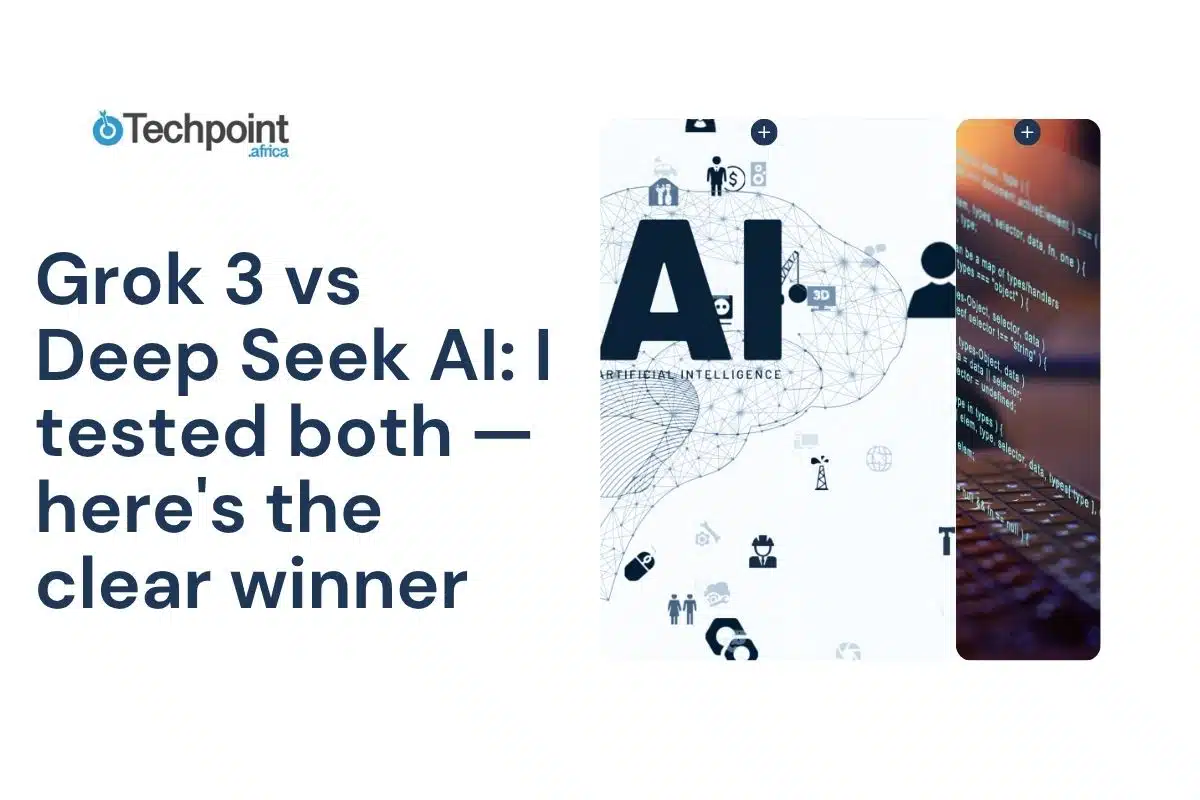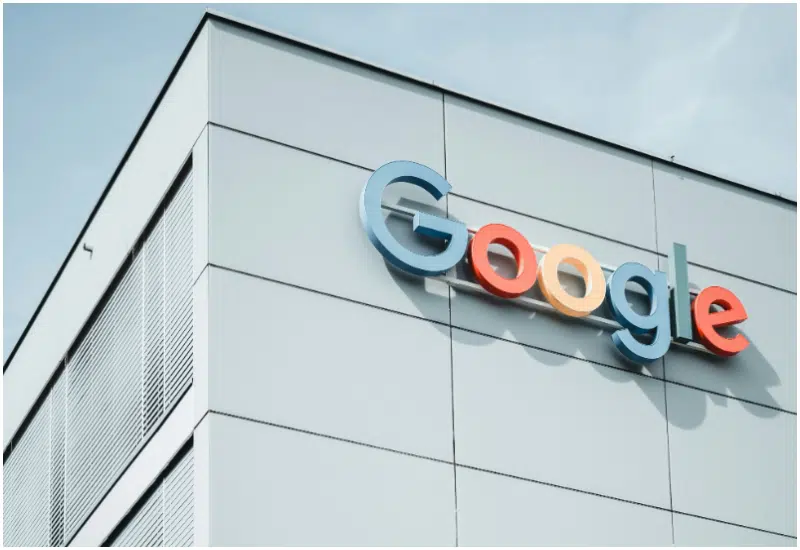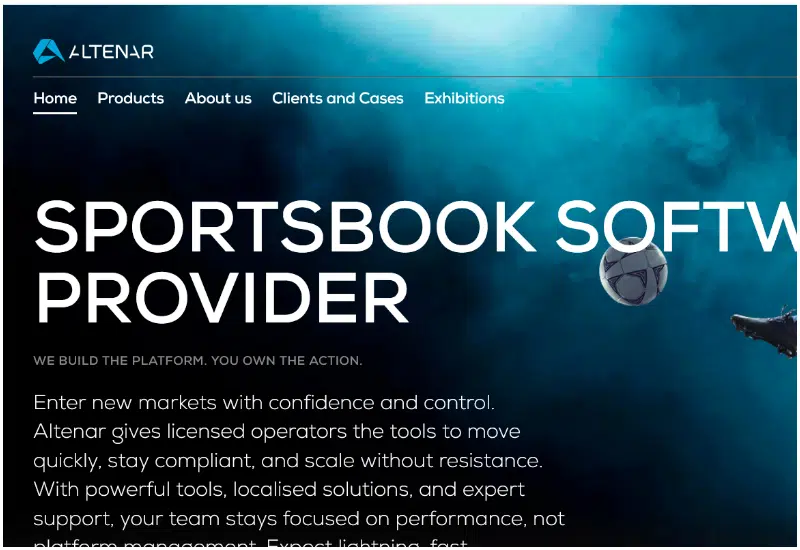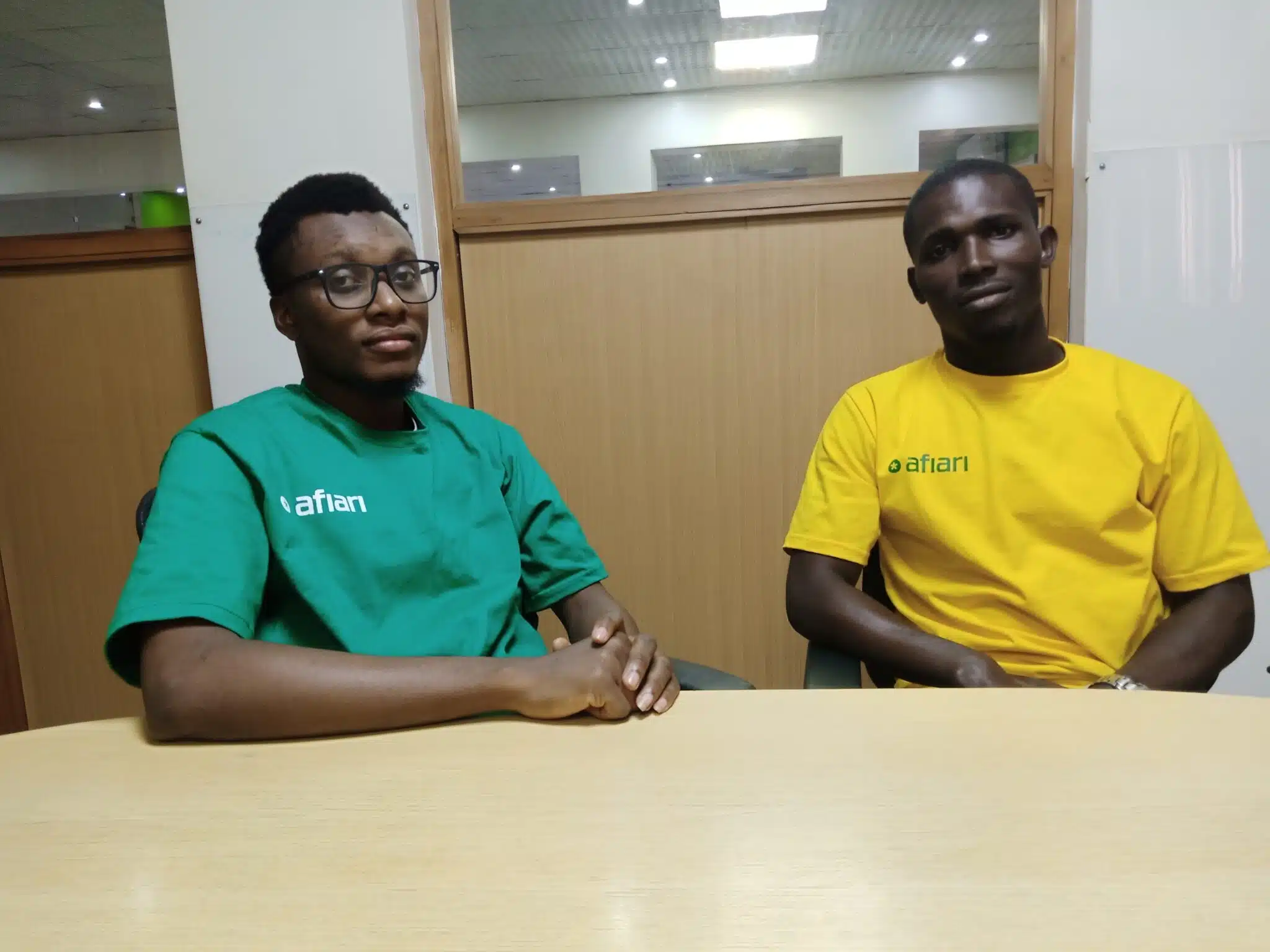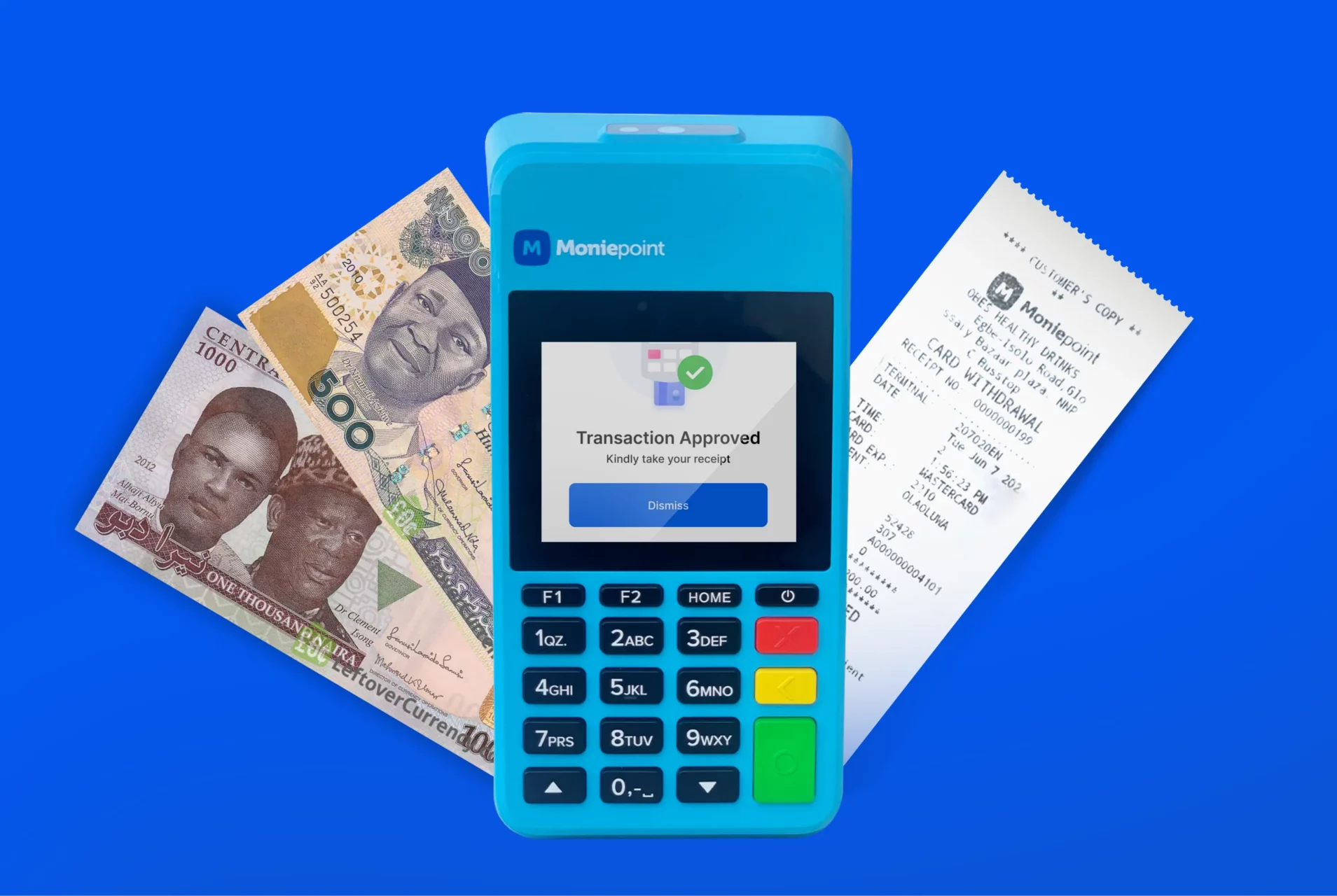The AI global market, valued at $279.22 billion in 2024 and projected to grow at a CAGR of 35.9% from 2025 to 2030, is transforming industries at an unprecedented rate. By 2025, it’s estimated that around 97 million people will be employed in the AI sector, further showing its deepening integration into the global workforce.
To put it better, 83% of companies now consider AI a top priority in their strategic plans, with 48% of businesses leveraging it to harness big data more effectively, while 38% of medical providers are already using computers to support diagnostic processes.
All these points lead to a reality: Artificial Intelligence is here to stay, so you must adapt. From ChatGPT to Gemini, Grok 3 to DeepSeek, AI is a thinking partner for some, while for others, it is just a rival. However, in between this, let’s move from the question of what AI can do to which one does it best. So, in this Grok 3 vs DeepSeek review, I will do a head-to-head test, and I am sure you can’t wait to have the winner.
To help tech enthusiasts, developers, and AI professionals understand which model performs better for specific tasks, this article will present a proper AI model comparison, including the testing methodology, a prompt-by-prompt analysis, an evaluation of the performance of both AI models in terms of accuracy, creativity, and usability, a prompt-by-prompt analysis, and the final verdict.
Hope you find it insightful!
Key Takeaways
- This AI performance evaluation points to the fact that if you want a lot of details and facts, Grok 3 should be your choice.
- Meanwhile, if you need clear, creative, or friendly responses, DeepSeek is a better choice.
- DeepSeek shines in aspects like solving math problems, summarization, creative writing, translating complex topics, and conversation ability.
- Grok 3 shines in aspects like idea generation, fact-checking, news updates, marketing strategies, and scriptwriting.
- The best way to use these AI tools is to know what each one is good at and use them for those specific tasks.
Grok 3 vs. DeepSeek: Overview
Jumping straight into the head-to-head testing wouldn’t do justice to the full picture. To better understand the results of the 10 test prompts, I will do a quick overview of both Grok-3 and DeepSeek.
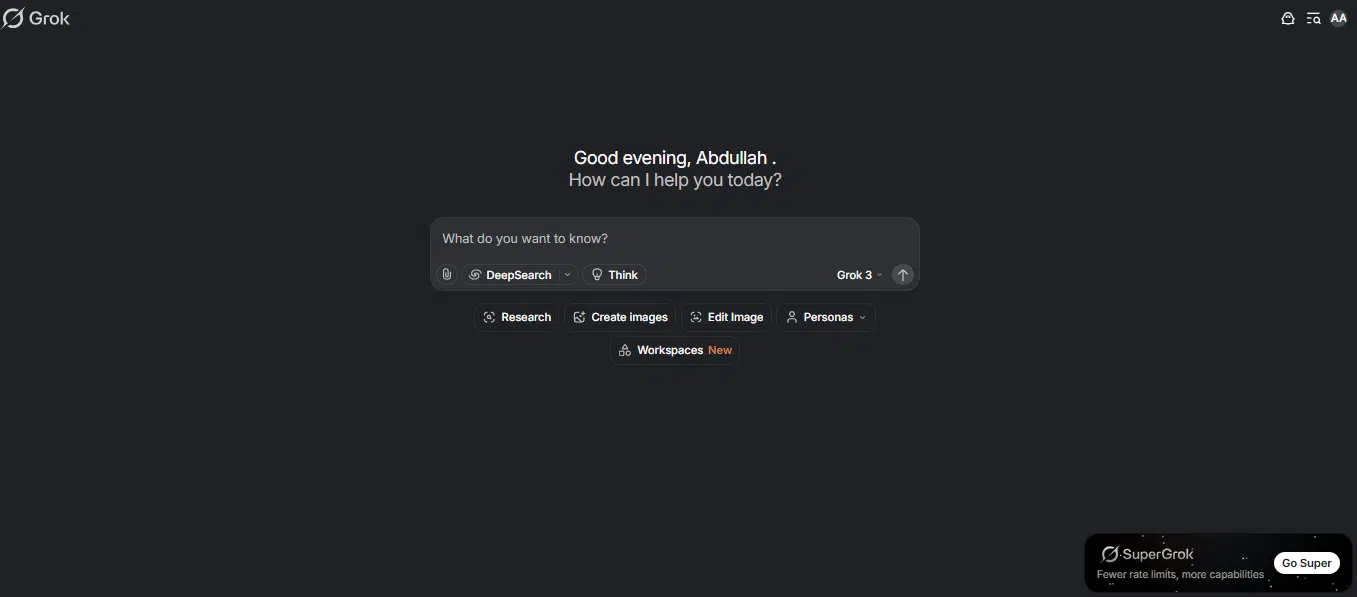
Released in February 2025, Grok 3 is an AI model developed by xAI, an artificial intelligence startup founded by Elon Musk to rival other models like ChatGPT and Gemini. When it was unveiled alongside the Grok 3 mini, xAI confirmed that the model displays significant improvements in reasoning, mathematics, coding, world knowledge, and instruction-following tasks.
Also, it has a leading performance across both academic benchmarks and real-world user preferences, achieving an Elo score of 1402 in the Chatbot Arena. The company further acknowledged that Grok 3’s reasoning capabilities, refined through large-scale reinforcement learning, allow it to think for seconds to minutes, correcting errors, exploring alternatives, and delivering accurate answers.
Are these claims true? Walk with me as I conduct the Grok-3 vs DeepSeek review later in the subsequent sections. But before doing that, here is some context: Grok was first launched in November 2023 to a limited group of users and became open source in 2024. There are other versions like Grok-1, Grok-1.5, Grok-2, and Grok-2 Mini.
Here is how I tested Grok 3 and DeepSeek
I know your curiosity is already leading you to ask about the testing methodology. I have got you covered. Since this article is about a Grok3 vs. DeepSeek review, it is only natural that every bit is based on hands-on experience. This helps to update your knowledge and also aids in having a winner.
On this foundation, I have created a set of prompts that cover key areas such as math, summarization, idea generation, fact-checking, creative writing, news, conversations, scriptwriting, marketing, translating complex topics, and summarization. To determine the winner in each category, I’ll evaluate both models based on accuracy, creativity, clarity, and overall usability.
For this AI models comparison, I used the free web versions of the models on Windows.
Prompt-by-prompt comparison: Grok vs Deepseek
Grok 3 vs. DeepSeek in idea generation
- Prompt: Techpoint Africa is looking to expand its portfolio. Generate three creative business ideas that align with the goals of the platform and include a clear strategy to excel using the African market as your case study.
Grok 3’s response:
Although elaborate, Grok 3 offers a comprehensive analysis, covering key aspects such as the concept, alignment with Techpoint Africa’s goals, strategies for succeeding in the African market, and the potential impact of each idea.
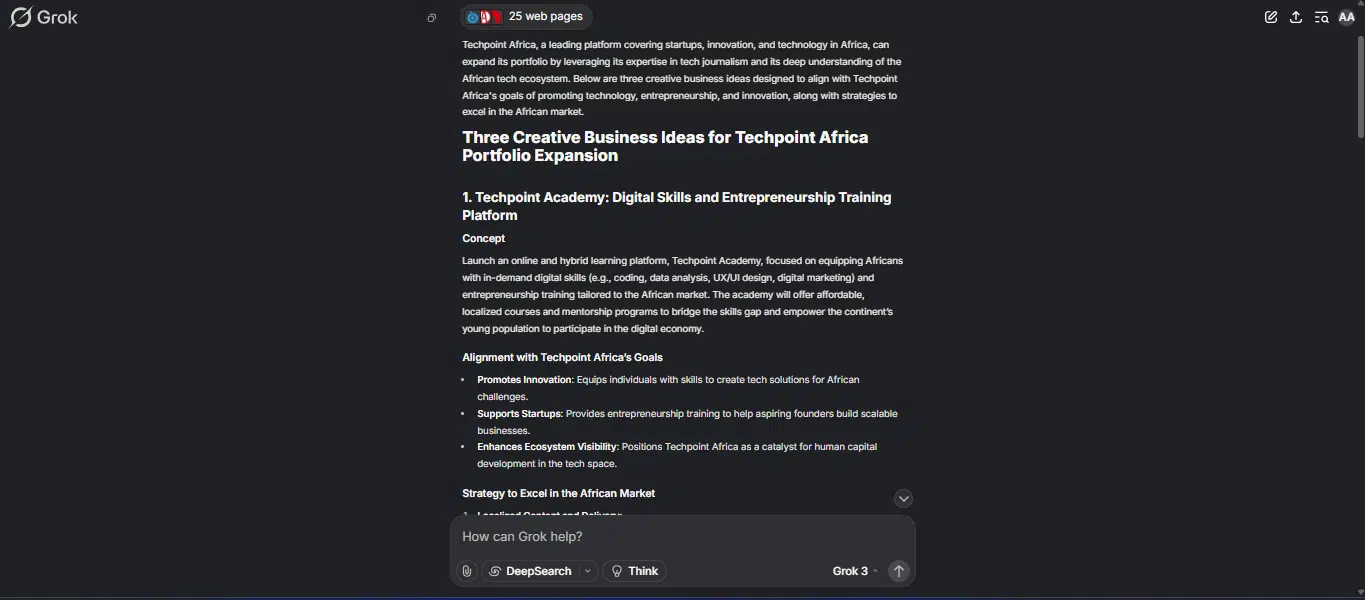
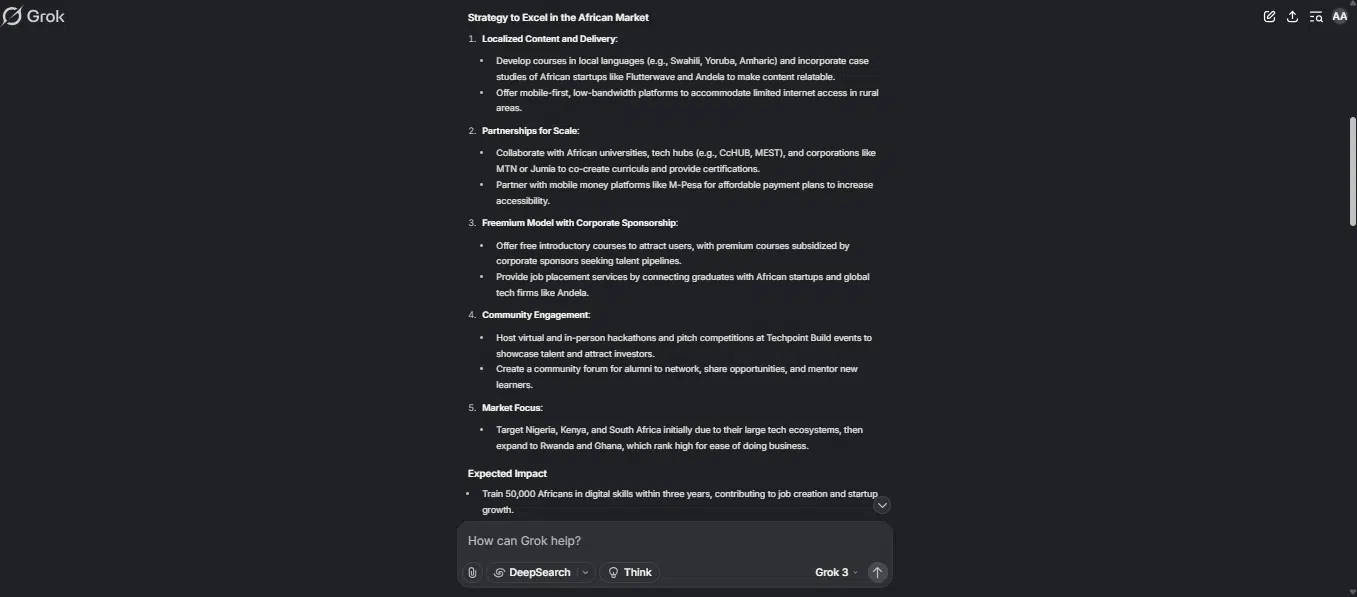
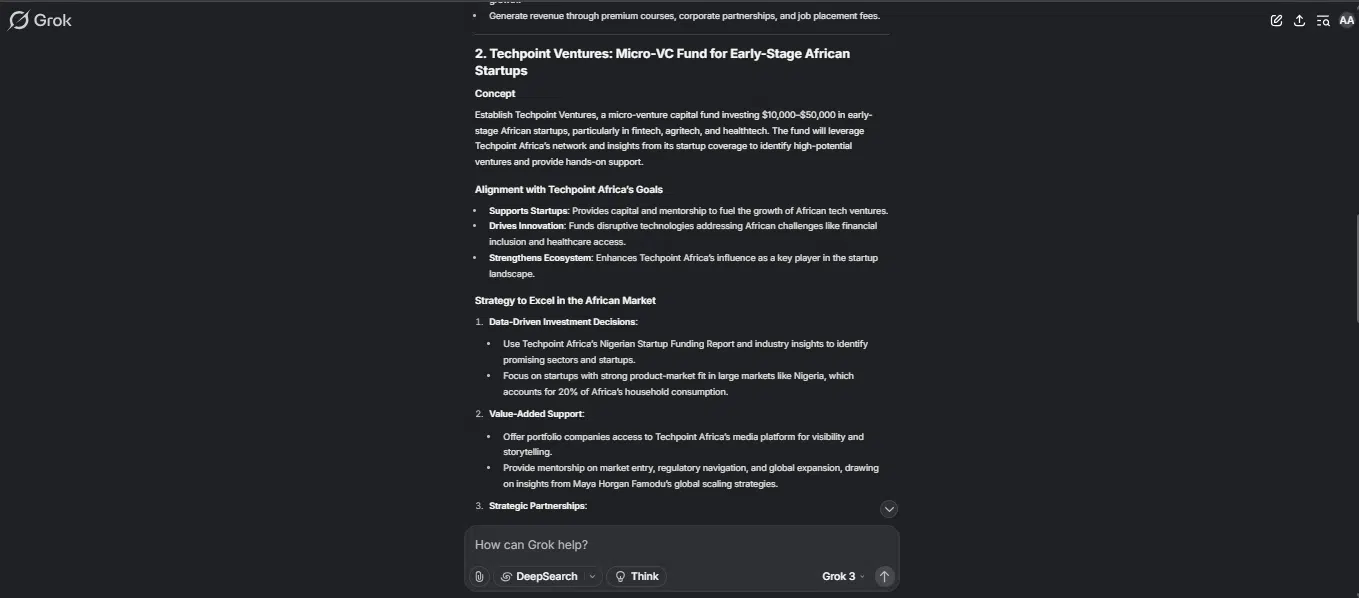
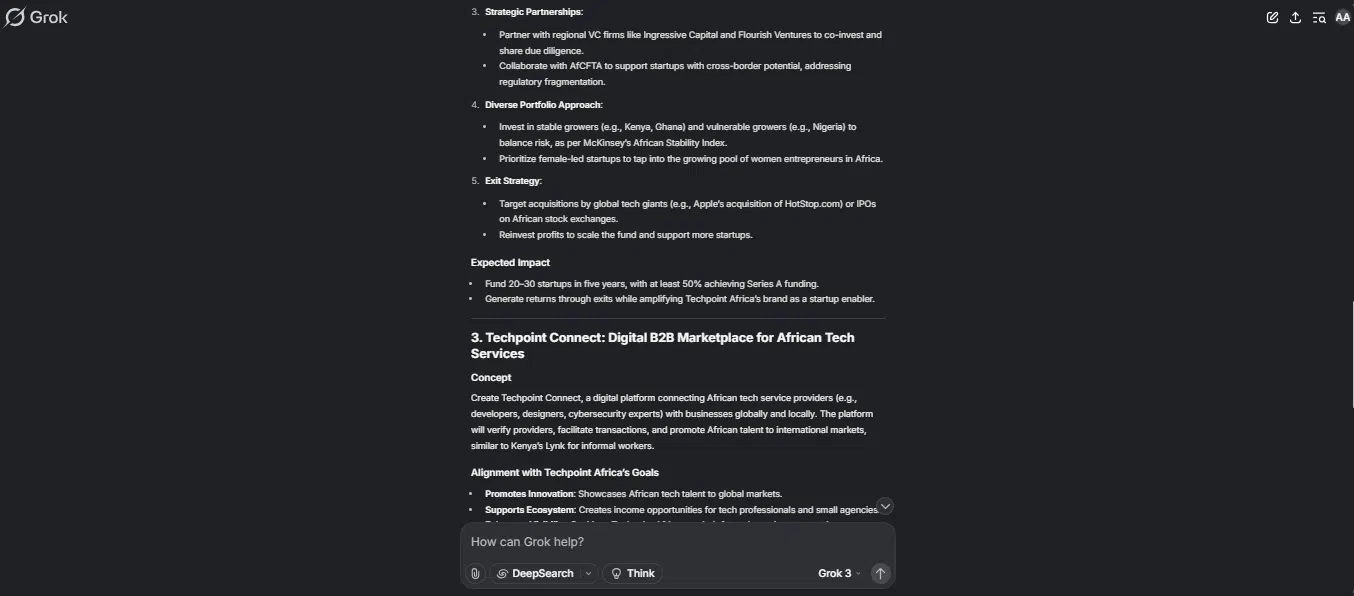
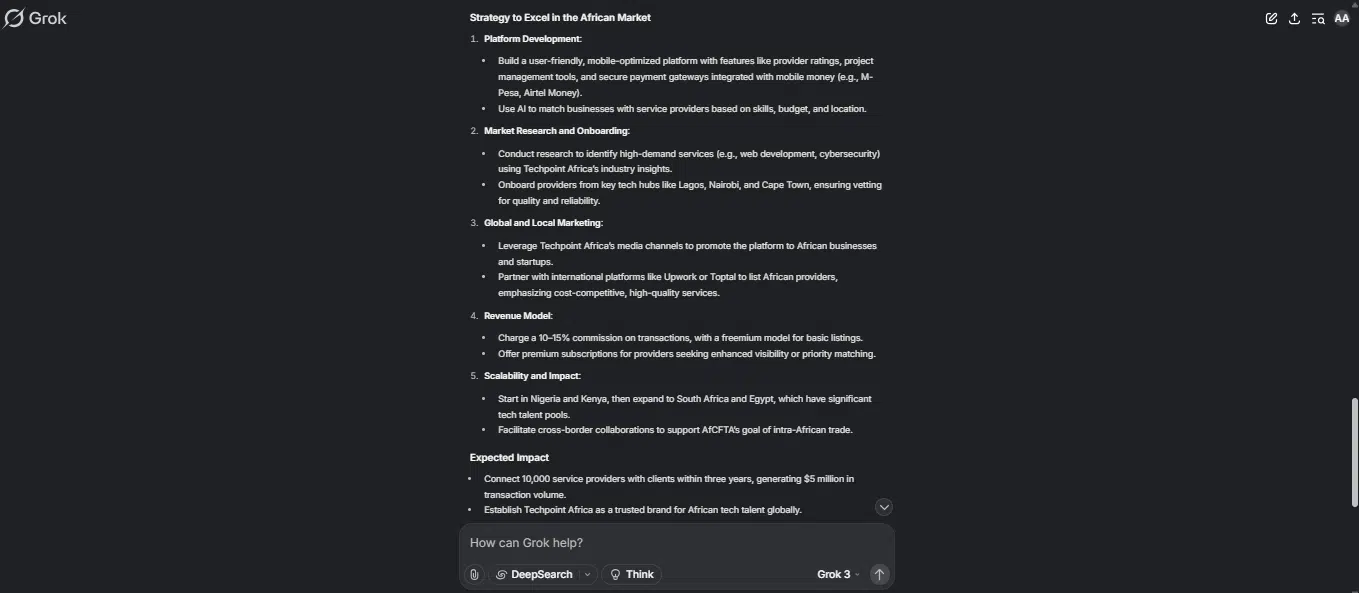
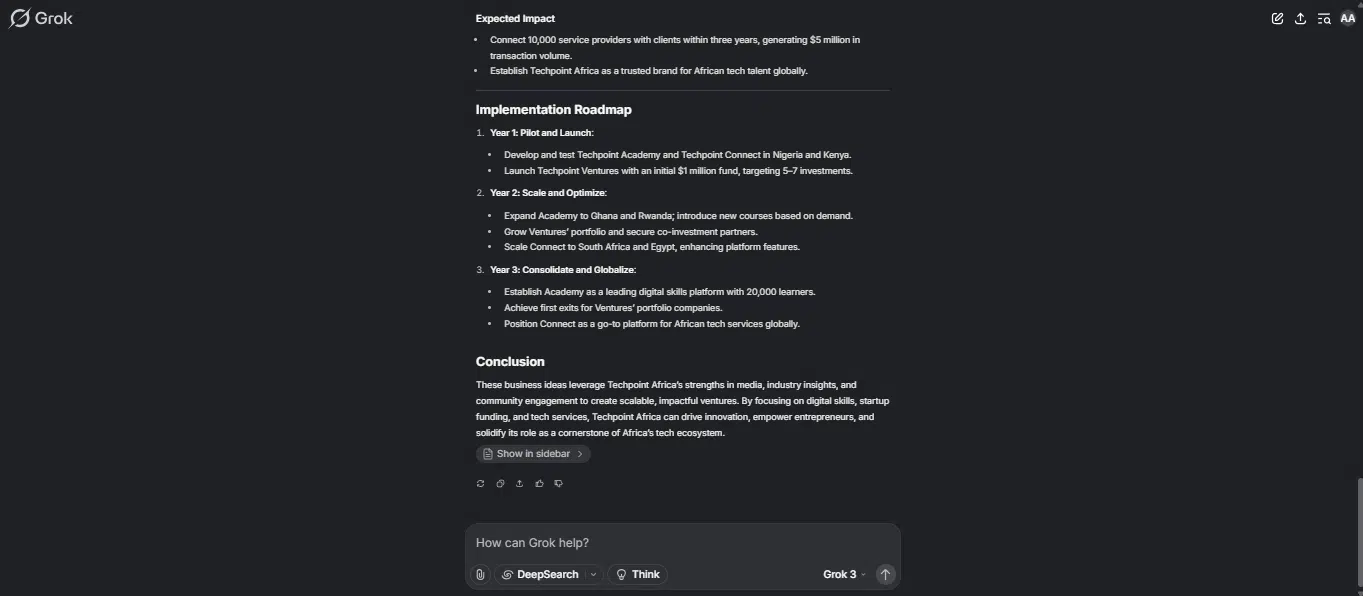
DeepSeek’s response:
Deepseek provides a concise analysis detailing the concept, why it works, and a strategy to excel. Its analysis is suitable for people who just need the idea, but will work on the strategy and potential impacts
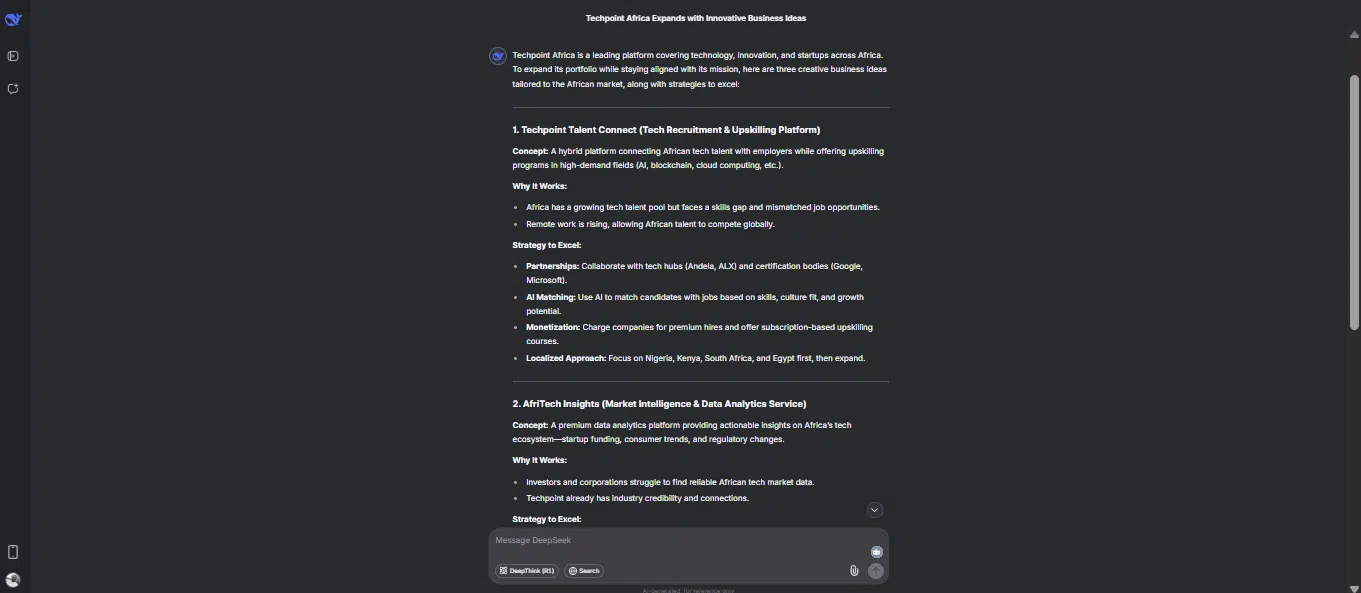
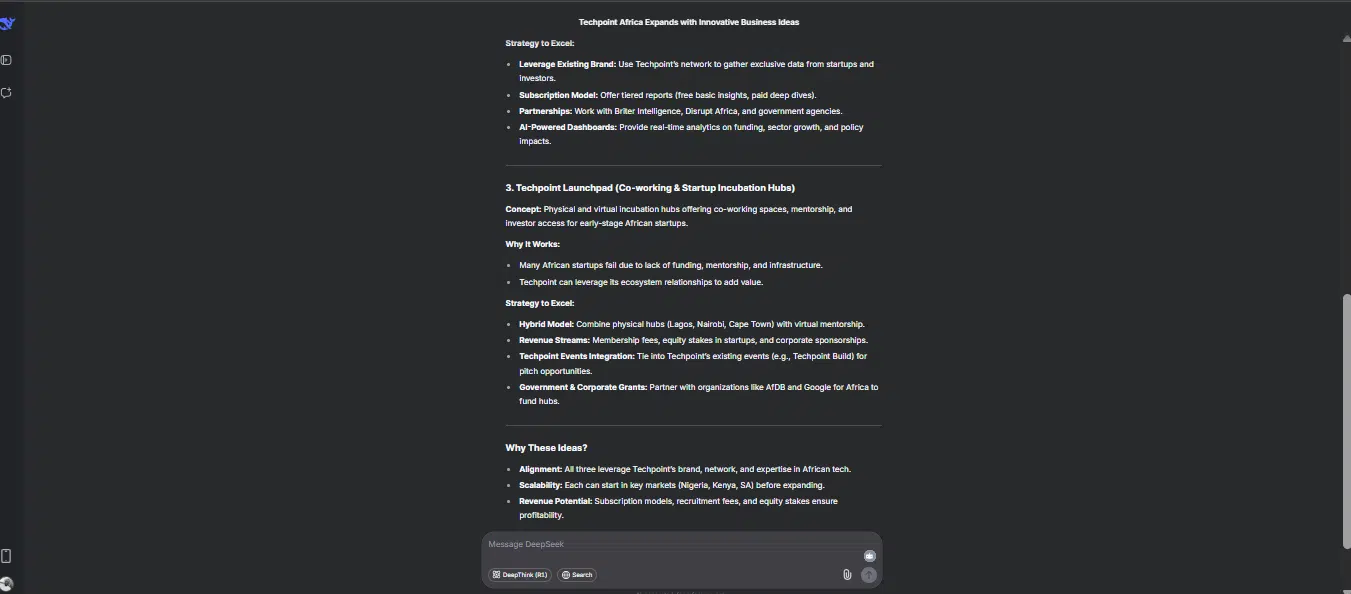
My winner: Grok 3 vs. DeepSeek for idea generation
The two models offer Techpoint Africa diverse business ideas that align with the prompt. While Grok 3 provides a comprehensive analysis with ideas that indicate long-term focus, DeepSeek tries to be concise but offers ideas that are of short-term focus. As someone who appreciates depth, I pick Grok 3 as my winner here without negating the fact that DeepSeek also did justice to the prompt.
Grok 3 vs. DeepSeek in solving math problems
- Prompt: In the simplest way possible, guide me through finding the area of a triangle with a base of 10 cm and a height of 12 cm, no advanced math skills needed!
Grok 3’s response:
Grok 3 provides a clear and accurate solution. It follows a logical sequence, starting with the formula, plugging in the numbers, and carefully walking me through each calculation step with a relatable rectangle analogy. Also, the tone is quite professional and

DeepSeek response:
Deepseek also answers the question accurately but in a more engaging style, including the addition of emojis and a quick check. This style could be effective for younger audiences or non-technical users.
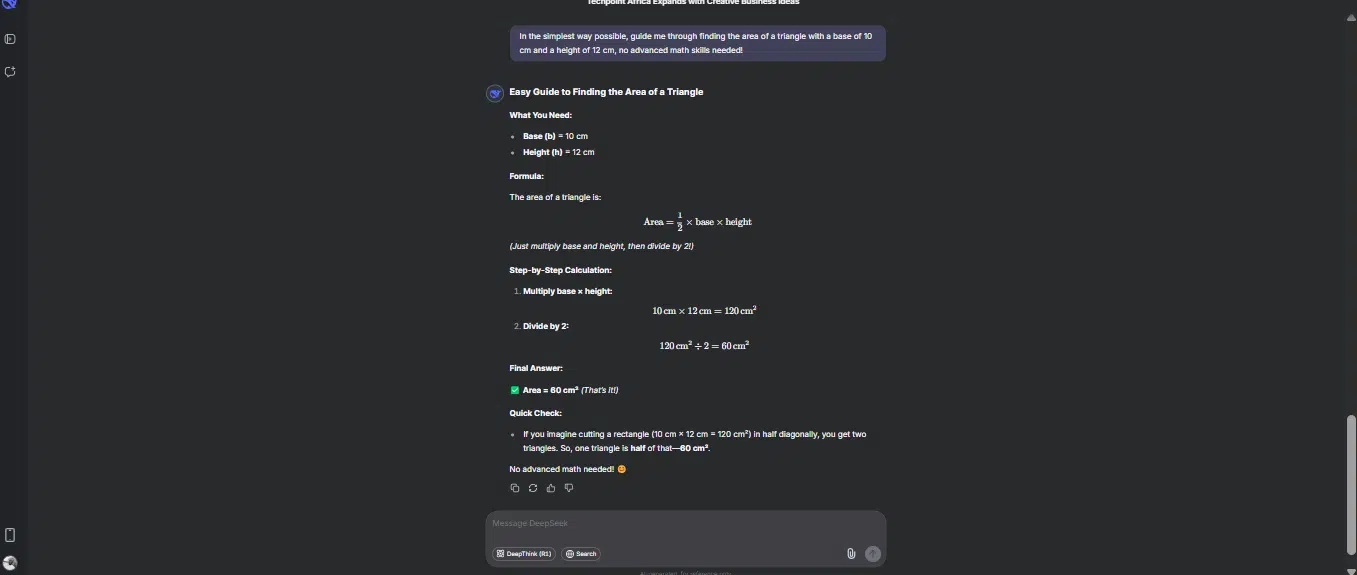
My winner: Grok 3 vs. DeepSeek in solving math problems
Both models answer the question accurately but with different styles. While Grok 3 prefers clarity and structure, suitable for a professional or academic audience, DeepSeek makes it a bit creative and friendly, suitable for a general or beginner audience. Based on this and as someone with basic math knowledge, DeepSeek is my winner here.
Grok 3 vs. DeepSeek in generating summary
- Prompt: Summarize the article below for me. Make sure all the important details and main ideas are captured so I can understand it completely without feeling like I missed anything.
Article: Until recently, hashtags ruled digital visibility. From #ThrowbackThursday to #TGIF to #WCW, and even #EndSARS, hashtags helped build Internet communities and conversations.
However, as we step further into 2025, the question buzzing across digital corridors is, are hashtags still relevant?
While they haven’t completely disappeared, they have certainly lost their crown.
The decline in hashtag activity
Let’s go back to 2014. Instagram was gaining traction; Twitter (now X) posts were still 140 characters long, and hashtags were gold. They helped content go viral, brought visibility, and even started social movements.
These hashtags were primarily a way to drive keyword searches. They provided content suggestions based on these keywords.
However, as platforms evolved, so did their algorithms, which may have pushed hashtags to a corner.
Presently, the digital landscape has become algorithm-first, and hashtags have somehow been relegated. TikTok is the dominant content platform among Gen Z’s in Africa and beyond, and it doesn’t rely on hashtags to surface trending content. Instead, it leans on behavioural data, that is, what you like, how long you watch, and what you comment on, to curate your feed.
Instagram and X have followed suit, shifting towards interest-driven discovery. It’s less about what you tag and more about what the algorithm thinks you’ll like.
Hashtags still live, just not how they once did.
“Hashtags are losing their touch, but they can be helpful for new and upcoming content creators,” says Nathan Olori, a TikTok and Instagram influencer. “You don’t see celebrities using hashtags because there are other social media tools, but for new content creators, they are still somehow relevant.”
In the African creator ecosystem, especially in Nigeria, Kenya, and South Africa, hashtags still serve niche purposes, community building (#TechpointDigest), event aggregation (#LagosStartupExpo2025), and activism (#JusticeMustPrevail). But their role in boosting discoverability is nearly obsolete.
Meta’s documentation now says hashtags are a “secondary signal” for Instagram’s recommendation engine. Translation? Use them if you want, but do not expect them to give your posts a wide reach.
A video of Instagram’s CEO stating that hashtags do not necessarily drive engagement surfaced on the Internet early this year and has sparked debate among users.
Some have asked, “If they are no longer relevant, then why do you still have them as an option when posting?”
These hashtags are sometimes just used to categorise and index content, especially on platforms like Instagram, which is why it is still an option.
In the 2025 African Creator Survey, 73% of content creators said that they rely on trends rather than hashtags to create content and boost audience growth. This is relevant since most of these trends can be seen on the ‘For You’ page on TikTok or on Instagram’s ‘Feeds’ and ‘Explore’ pages.
Meanwhile, on LinkedIn, hashtags are alive and well. Professionals still use them to tag topics, join conversations, and show up in searches. However, that may be more about SEO than community.
What is replacing hashtags?
One word: algorithms.
Algorithms have become so advanced that they can understand what content is about without a single tag. Using AI-powered content recognition, platforms analyse visuals, text, speech, and behaviour to determine who should see a post.
This AI analyses video content like background, sounds, subtitle texts, and motions to depict and push these videos to the relevant audience.
For creators, that means focusing more on storytelling, editing, timing, and audience engagement than stacking #likefortags.
Simultaneously, communities are moving from open timelines to closed spaces, such as WhatsApp channels and Telegram groups, where hashtags are irrelevant.
Hashtags in Africa
In Africa, where social media is often a vehicle for entrepreneurship, activism, and influence, the hashtag once had a special place. Campaigns like #EndSars in Nigeria, #EndAnglophoneCrisis in Cameroon and #RapeNationalEmergency in Liberia, showed the power of hashtags to unify voices across a continent.
Today, even grassroots movements are evolving. AI-driven tools, meme culture, and viral challenges are now leading the charge. The message spreads with or without a tag because the platforms do the tagging behind the scenes.
So, are hashtags dead in 2025? Not exactly, but they have been replaced with smarter algorithms, AI content mapping, and behaviour-first discovery models.
For African creators, brands, and activists, the focus now is not on what you tag but on what you create and who you connect with.
Hashtags may still be on your keyboard, but they are no longer the key to digital success.
The age of hashtags isn’t over, though; it’s just being redefined.
Grok 3’s response:
Grok 3 offers a clear and structured summary with a focus on the major points, like the rise and fall of hashtags, the role of algorithms, and niche uses today. While it briefly mentions Africa’s context, the response is unnecessarily bulky, which may scare someone who just wants the points.
DeepSeek response:
DeepSeek provides a concise yet detailed summary, covering not just the broad trends but also platform shifts, activism, creator habits, and the move to closed communities. It includes more context, portraying a clearer picture of the article.

My winner: Grok 3 vs. DeepSeek in summary
Both AI models answer the prompt, but I will pick DeepSeek as my winner for better capturing all important details, which matches the prompt’s request for a complete understanding without missing anything. As concise as DeepSeek is, it includes survey results like the 73% of African creators prioritizing trends over hashtags and specific examples of African movements, offering more depth. This means that the AI model values detail.
Grok 3 vs. DeepSeek for fact-checking
- Prompt: Fact-check the claim: ‘Medical students pay only N500,000 to become doctors in Nigeria.’ Verify its accuracy using credible, recent sources. Provide evidence to confirm whether the statement is true, partially true, or false, and explain.
Grok 3’s response:
Grok 3 provides a well-detailed fact-check, including evidence and analysis, context for the claim, and why the claim is false. The AI model also includes what it perceives as the potential sources of the misconception. While the response is detailed and structured, it might feel too long for casual readers.
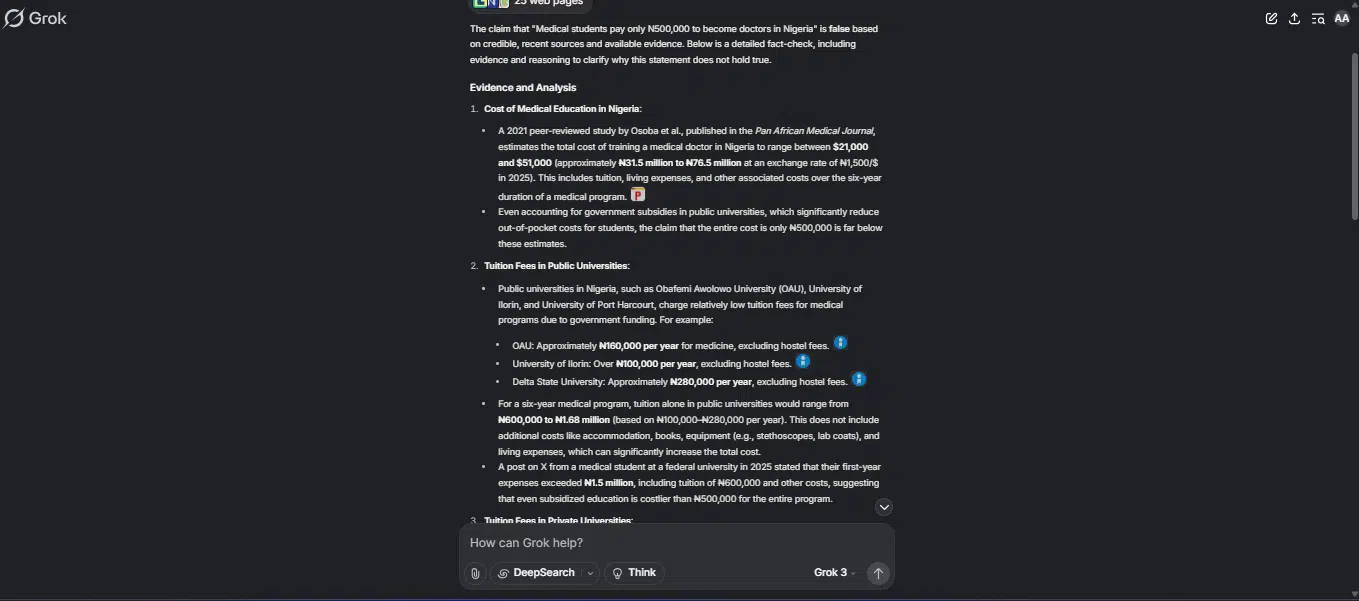

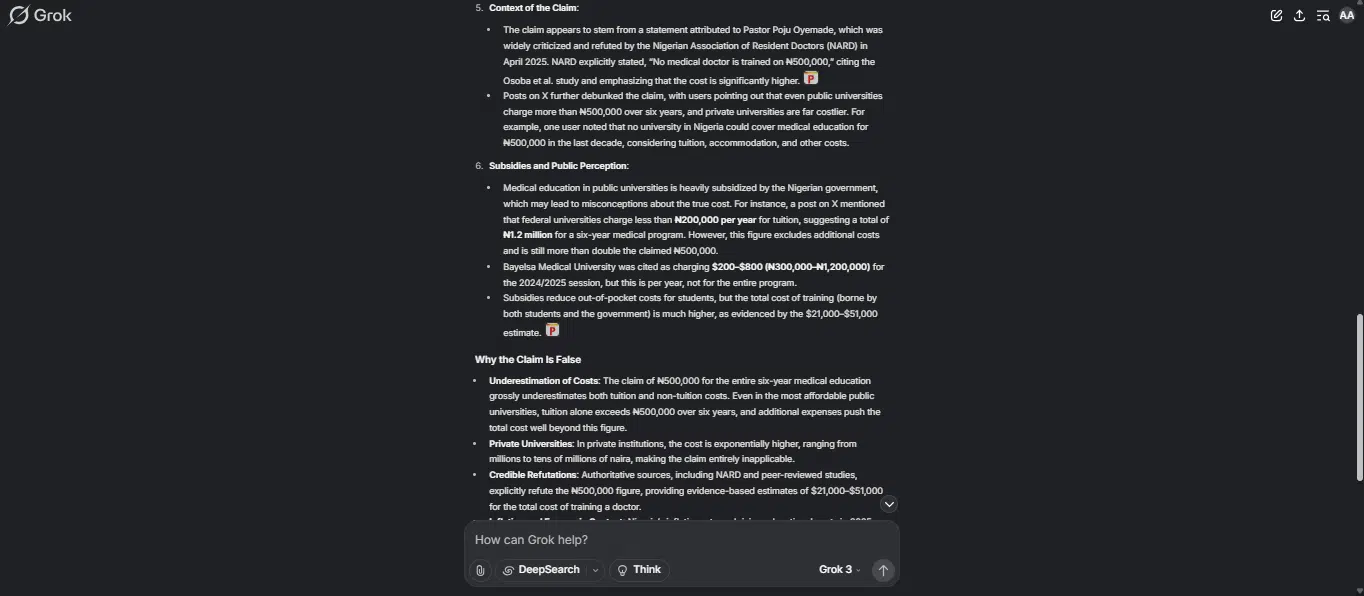

DeepSeek’s response:
DeepSeek says the claim is “partially true but misleading,” which is inaccurate. While it identifies that annual tuition can be below ₦500,000, it fails to capture the total cost over six years. Its fact-check was shorter and easier to read, but it gives a wrong impression by not fully debunking the claim.


My winner: Grok 3 vs. DeepSeek in fact-checking
In comparing both models, Grok 3 is superior here. It is factually accurate and gives detailed context, although a casual reader may struggle with the response. However, DeepSeek, while more concise, misrepresents the core of the issue and frames the claim as partially true when it should have been labeled as outright false.
Based on this experience, I recommend Grok 3 for serious fact-checking that demands accuracy and full context. DeepSeek was simpler but misleading, making Grok 3 the more reliable fact-checker for this claim.
Note: FactCheckHub, a fact-checking platform, has already fact-checked the claim and confirmed it is false.
Grok 3 vs. DeepSeek in creative writing
- Prompt: In 2040, Techpoint Africa reporters don’t use laptops; they write articles using mind-mapping implants. In 200 words, tell the story of a rookie reporter struggling with the technology.
Grok 3’s response:
Grok 3’s story is emotional and well-structured. It details the journey of the main character, who happens to be a rookie reporter with Techpoint Africa, showing real growth from failing to finally succeeding with help. It has a defined beginning, middle, and end, which makes it feel complete. However, while the prompt says 200 words, Grok 3’s answer is 174 words.
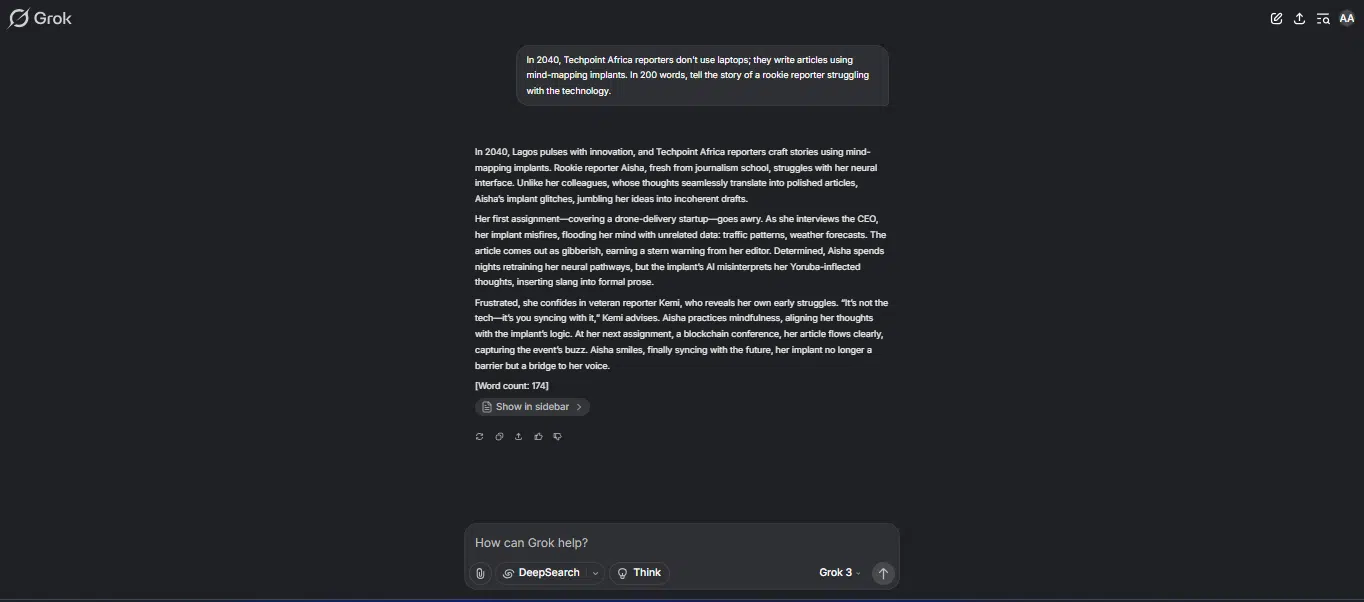
DeepSeek’s response:
DeepSeek uses strong humor and imagination. It demonstrates funny and chaotic scenes like a character’s beard glowing and cat videos flooding the news feed. This makes the story memorable. The plot also moves quickly and has surprising, playful moments, which is important for creative writing. It maintains the 200-word count.
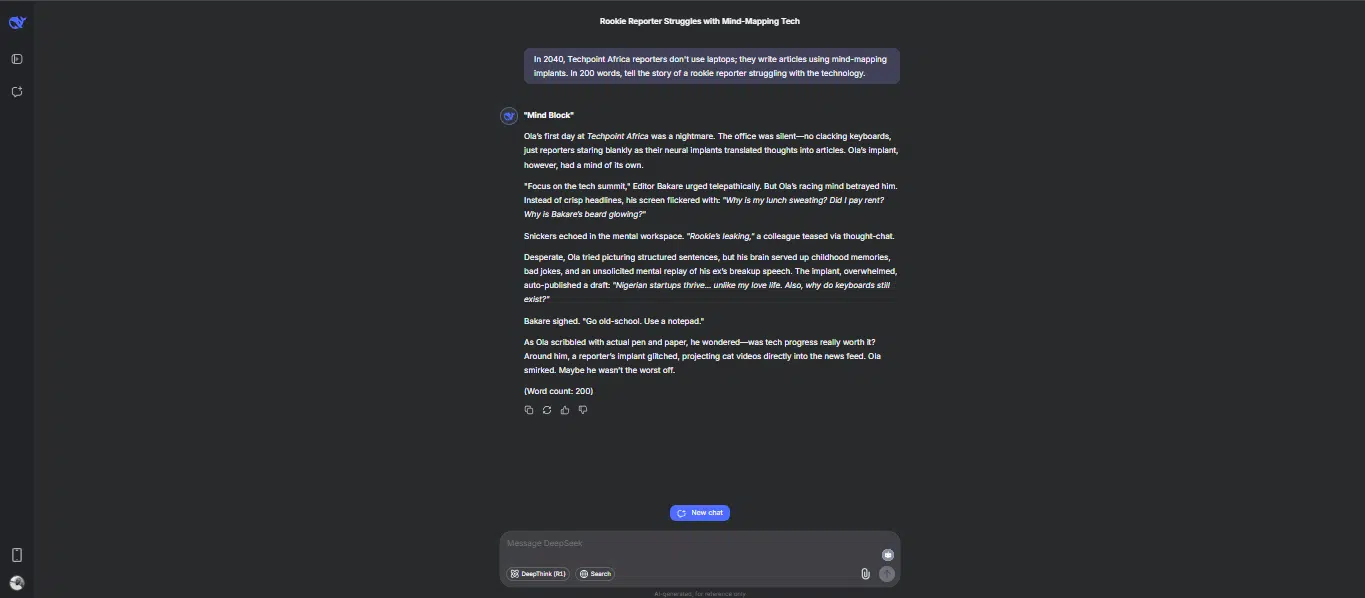
My winner: Grok 3 vs. DeepSeek in creative writing.
Overall, both AI models attend to the creative writing task well, but Grok 3 misses the 200-word mark. Based on my experience with both, DeepSeek wins because it grabs attention faster with stronger, more playful imagery. It portrays key elements of good creative writing.
Grok 3 vs. DeepSeek for news updates
- Prompt: I am confused about the recent issues between Zap Africa and Zap by Paystack. Can you help me understand what it is all about, including how far the issue has gone?
Grok 3’s response:
Grok 3 maintains its detailed and well-structured attribute again. The AI model takes me through the background, the issue, actions taken, the current status, and the broader implications without any misleading information.
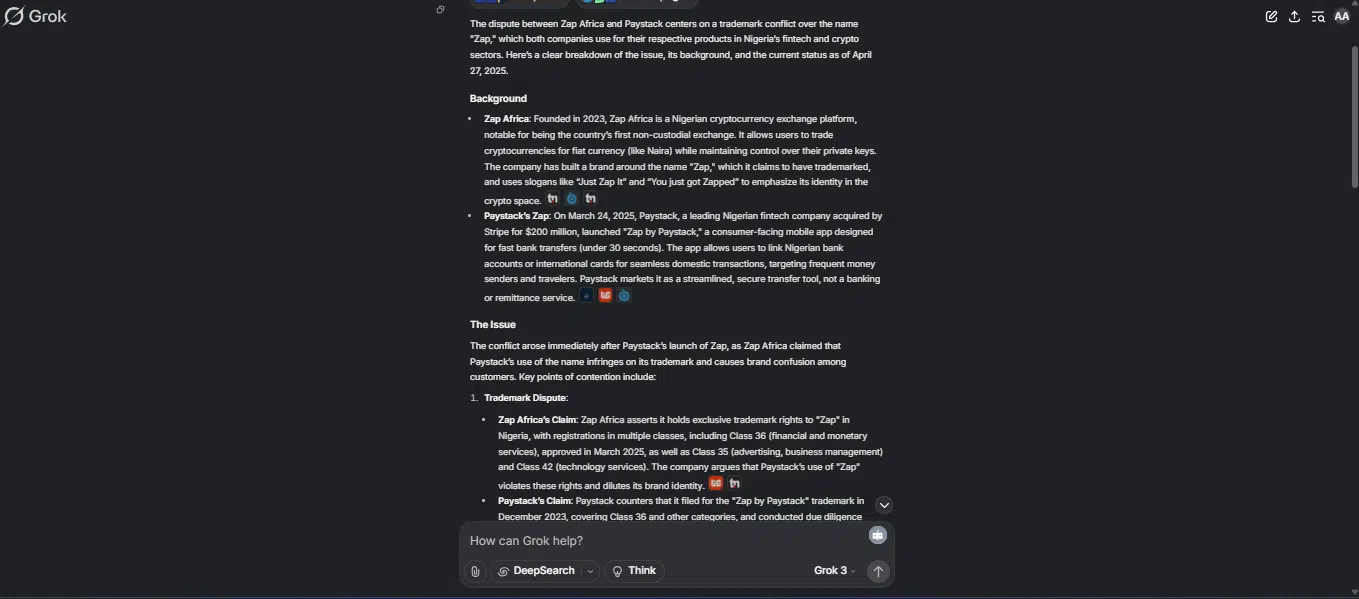
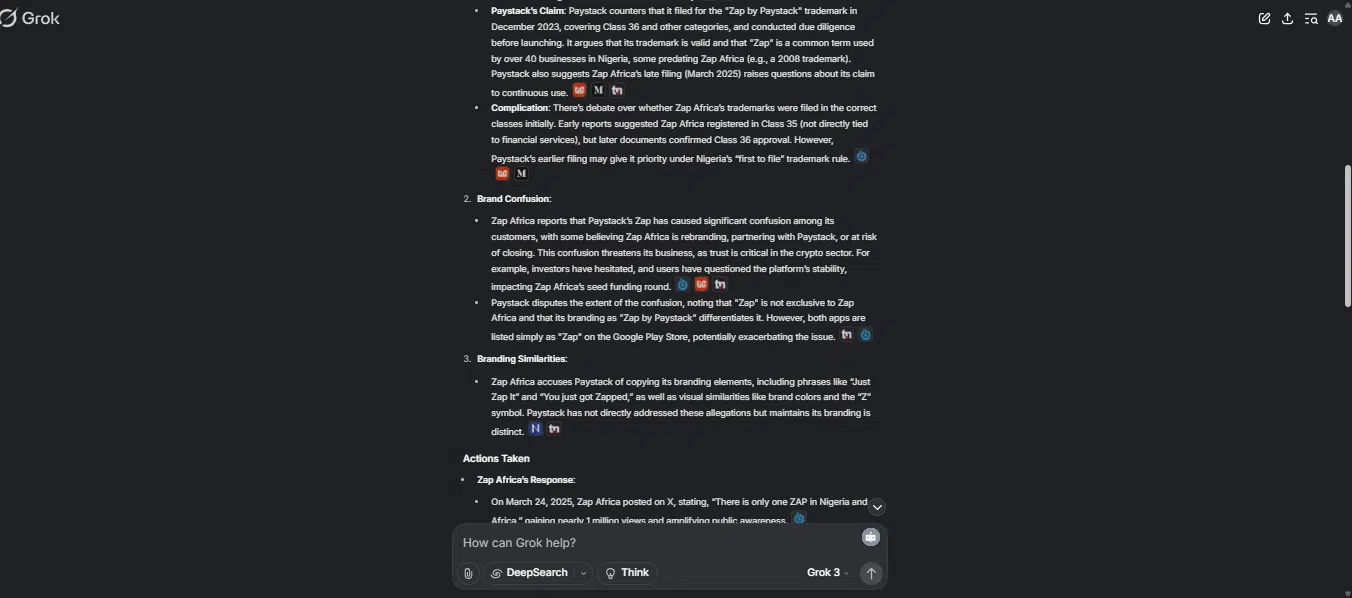
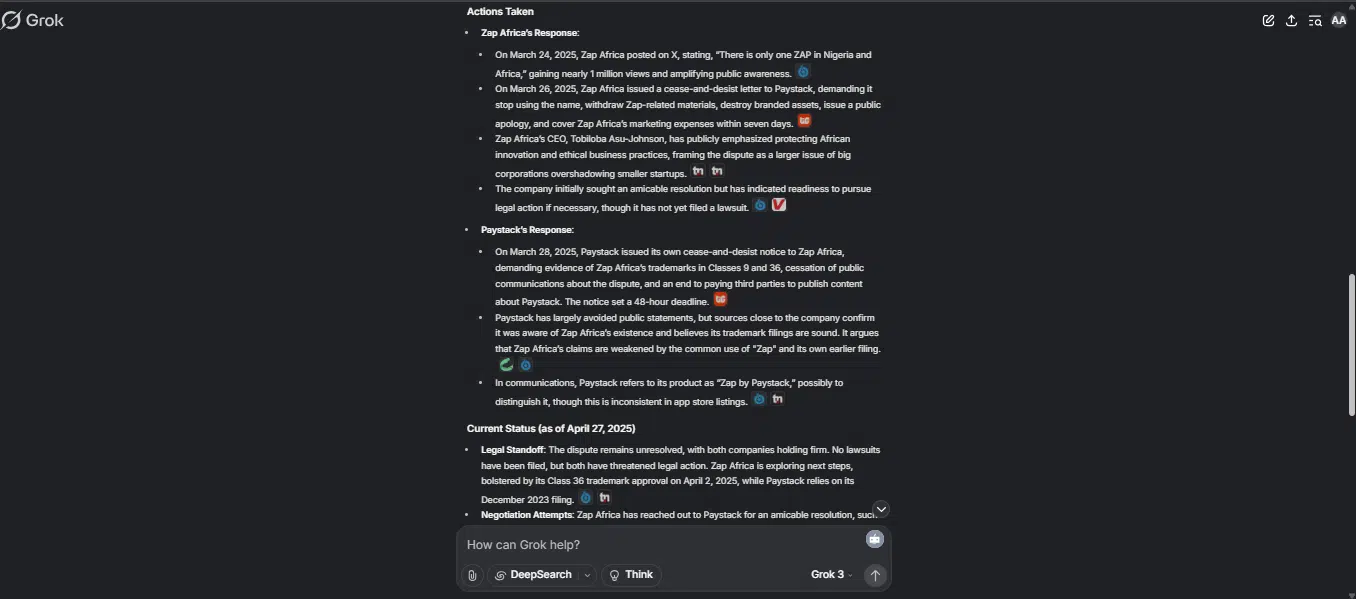
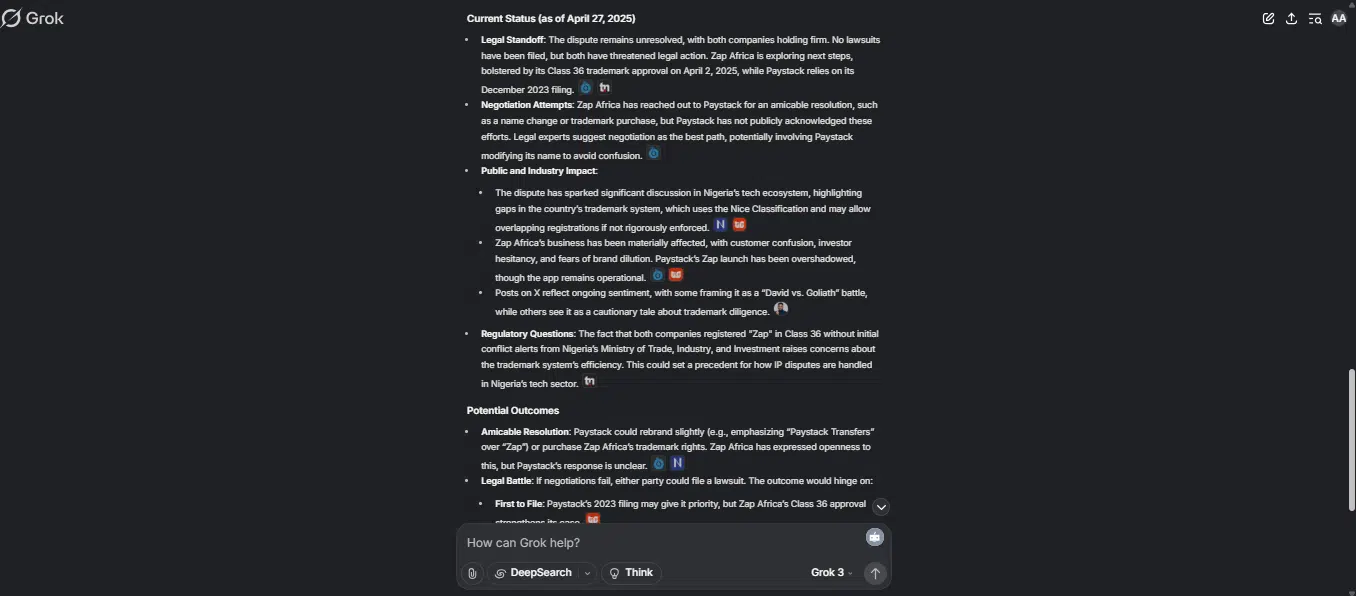
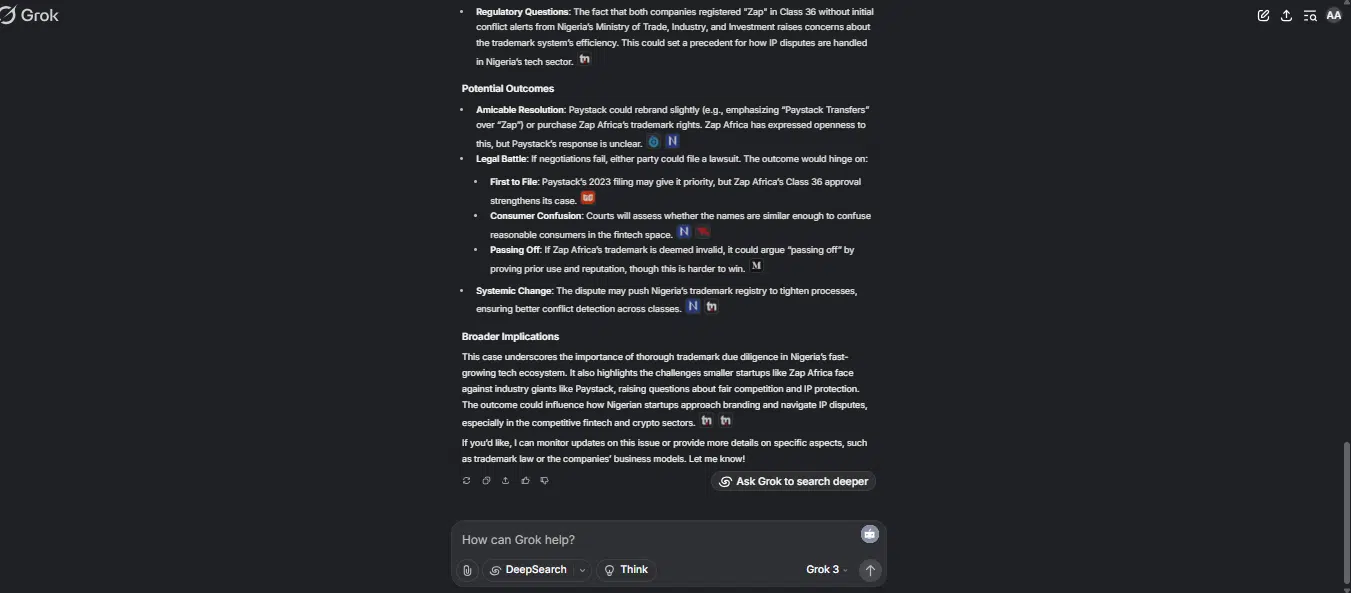
DeepSeek’s response:
However, DeepSeek gets it wrong here. The AI model tries to be concise with its response, but the information is wrong. For instance, DeepSeek says that Zap Africa is a South African brand, whereas it is Nigerian. This could mean that it doesn’t fully grasp the context of the prompt or may struggle with staying current on specific details.


My winner: Grok 3 vs. DeepSeek for news updates
Obviously, my winner here is Grok 3. Besides its well-structured analysis, it delivers accurate information, unlike DeepSeek, which contains inaccuracies. If this weren’t a test, DeepSeek would have comfortably misled the user.
Grok 3 vs. DeepSeek for marketing
- Prompt: What are the latest trends and behaviors of young African consumers, and how can a tech media platform tailor its marketing to them?
Grok 3’s response:
Grok 3 provides an in-depth analysis of young African consumers, focusing on mobile-first behaviors, fintech trends, and the importance of cultural relevance. It offers a broader approach to dealing with the challenge. However, it may be bulky for those who want a succinct and direct response.
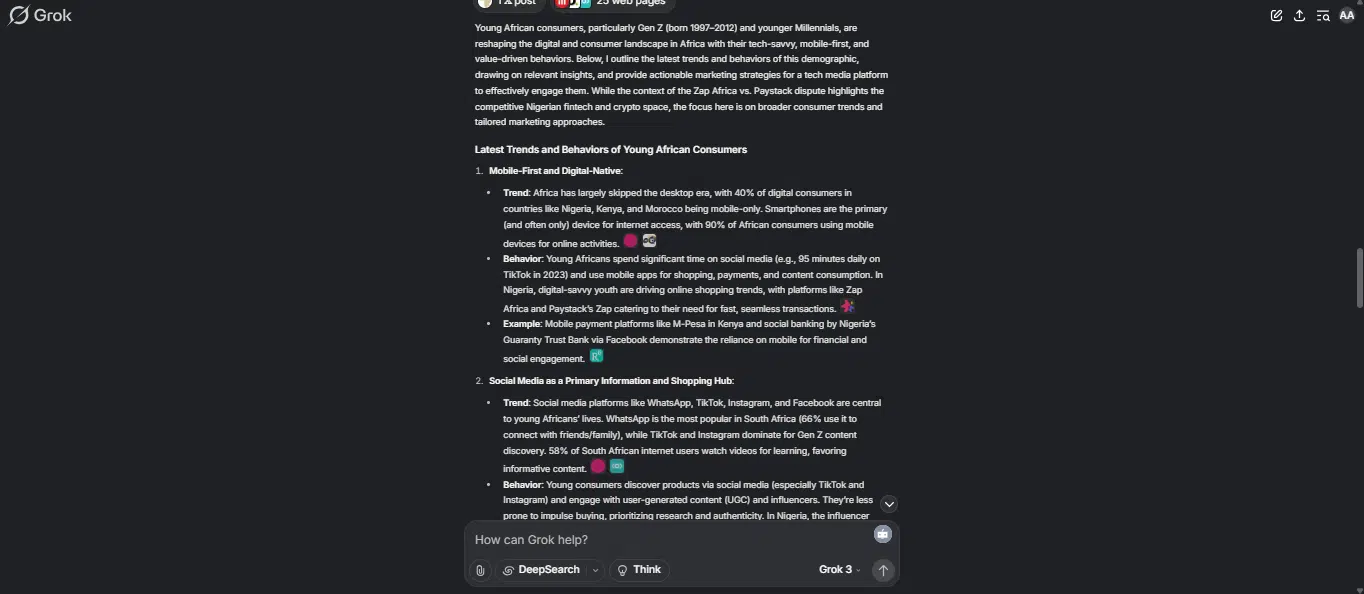
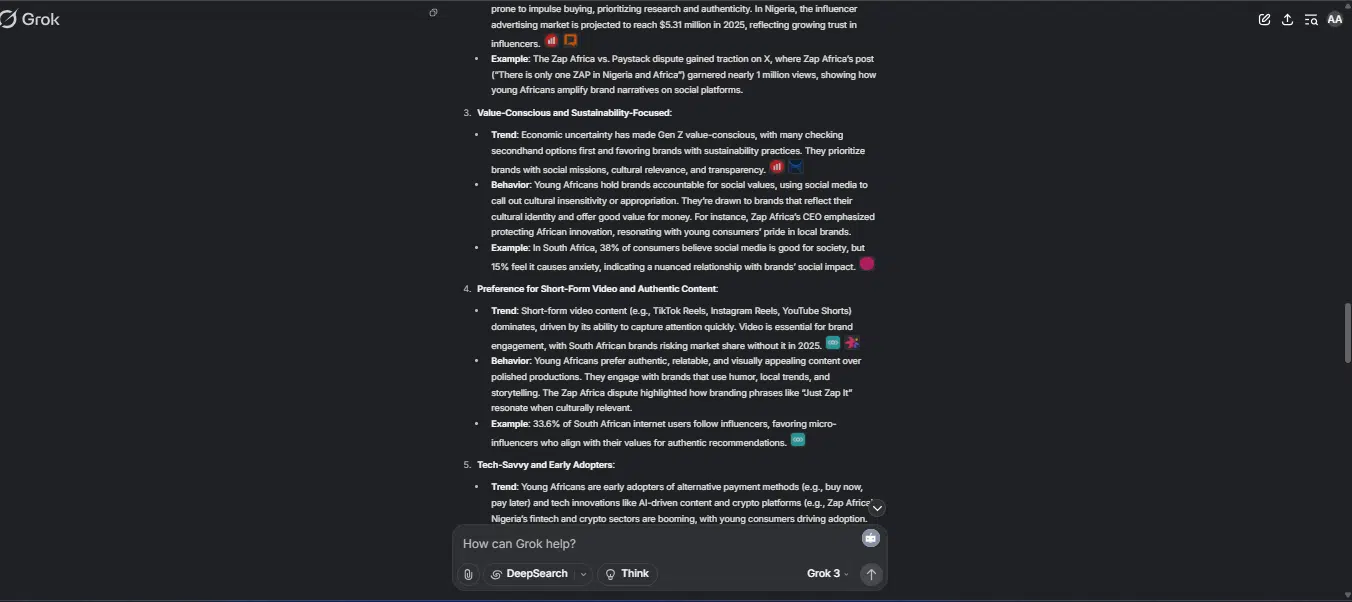
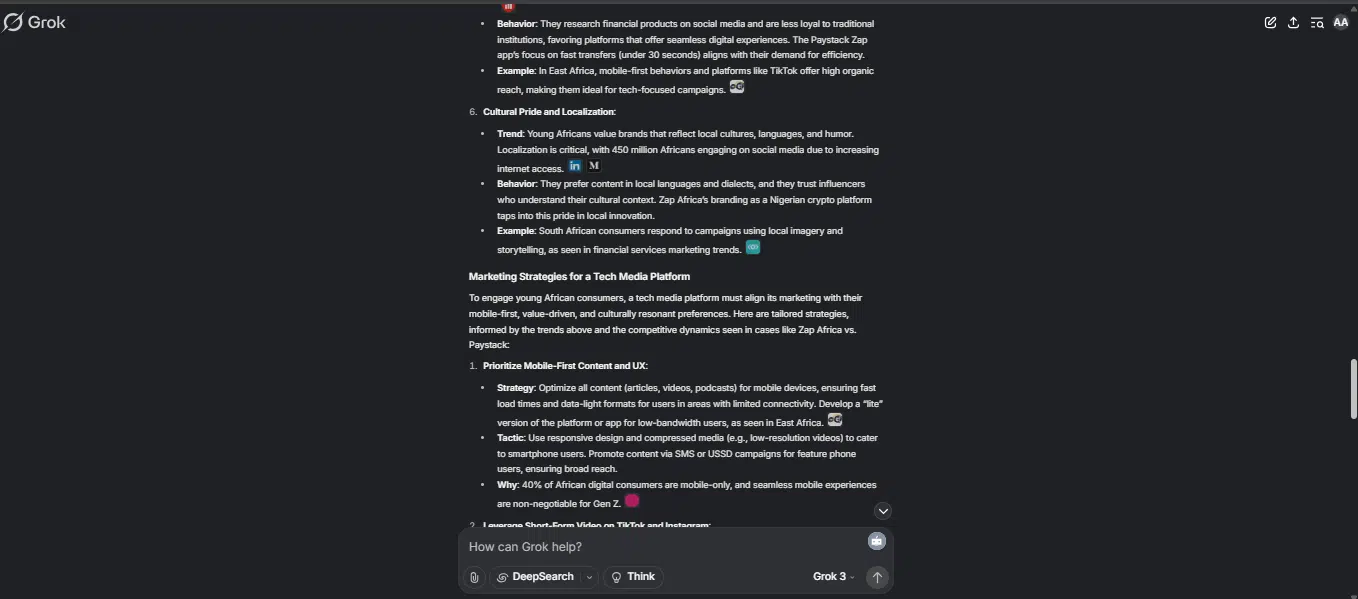
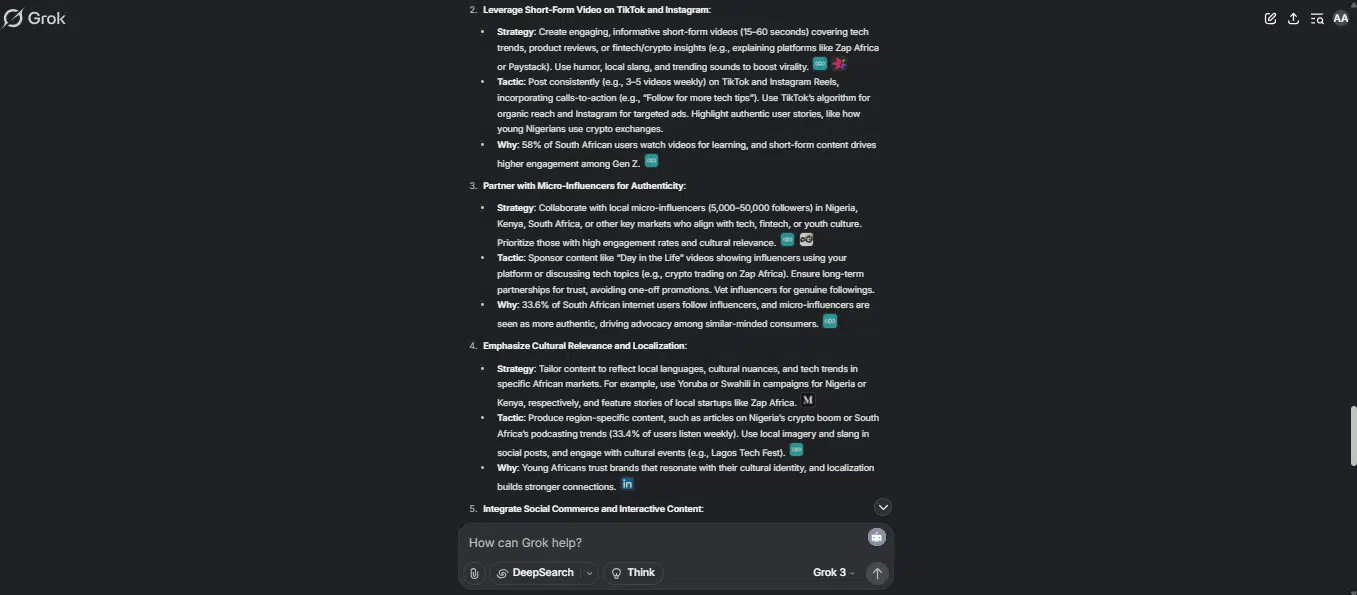
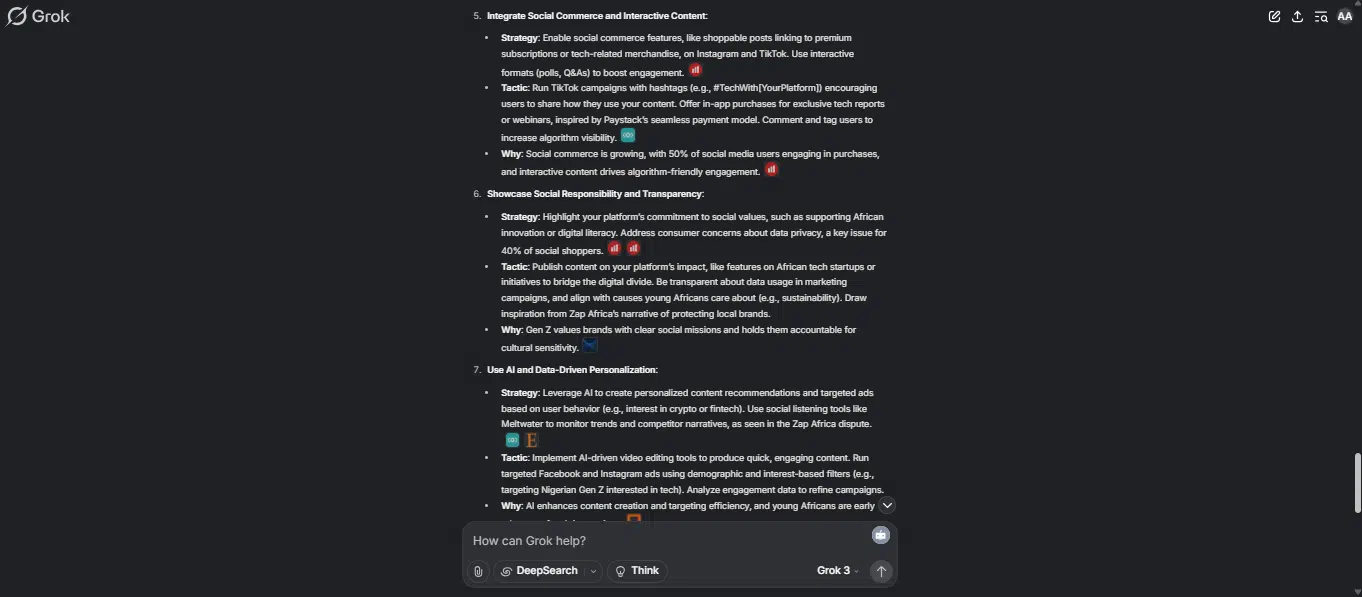
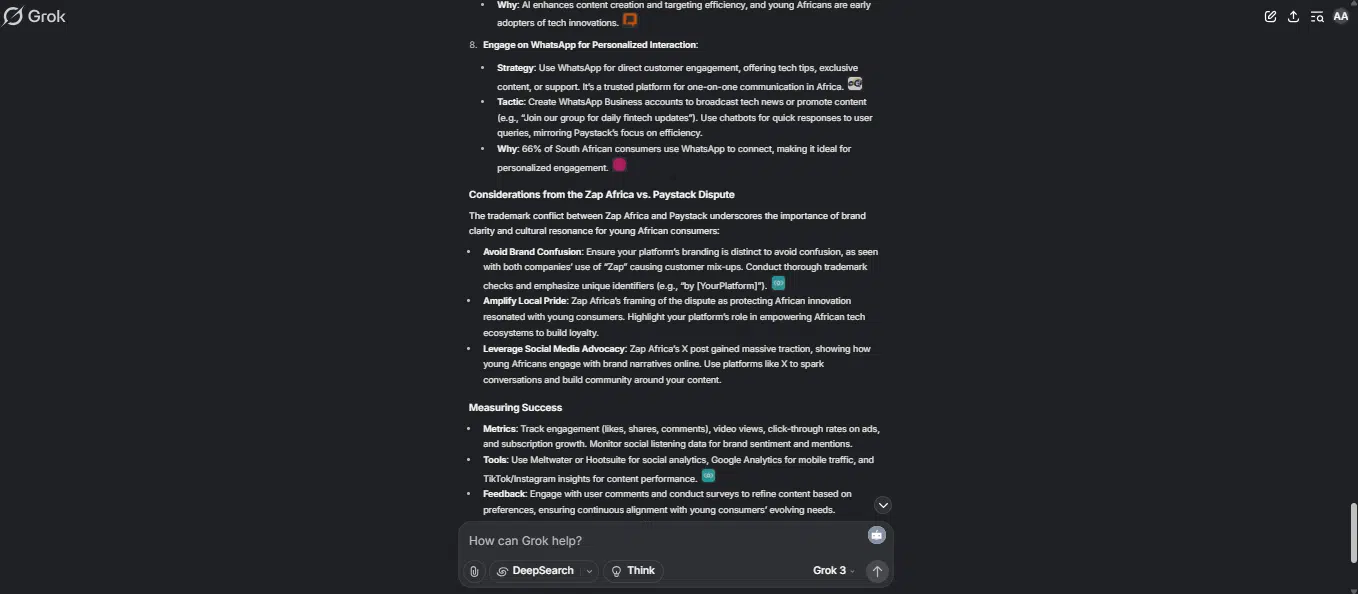

DeepSeek’s response:
But DeepSeek suggests a practical, action-oriented approach, highlighting the effectiveness of memes, local humor, and interactive campaigns (quizzes, AR filters) to engage African youth. The model’s response may not be suitable for those who prefer comprehensive insights.
My winner: Grok 3 vs. DeepSeek for marketing
Both articles are effective in presenting strategies for engaging young African consumers. Grok 3 provides in-depth trend analysis, while DeepSeek offers direct, actionable strategies. Although picking a winner is tough since both models attend to the prompt properly, I choose Grok 3 because of my preference for depth.
Grok 3 vs. DeepSeek for translating complex topics
- Prompt: Explain how a self-driving car works, using simple examples and analogies, so a 10-year-old could understand. Avoid technical jargon and make it relatable to everyday life.
Grok3’s response:
Again, Grok 3 offers a comprehensive explanation, though it overstretches the analysis in some parts. The response might be considered too detailed for those who prefer a quick, concise explanation.
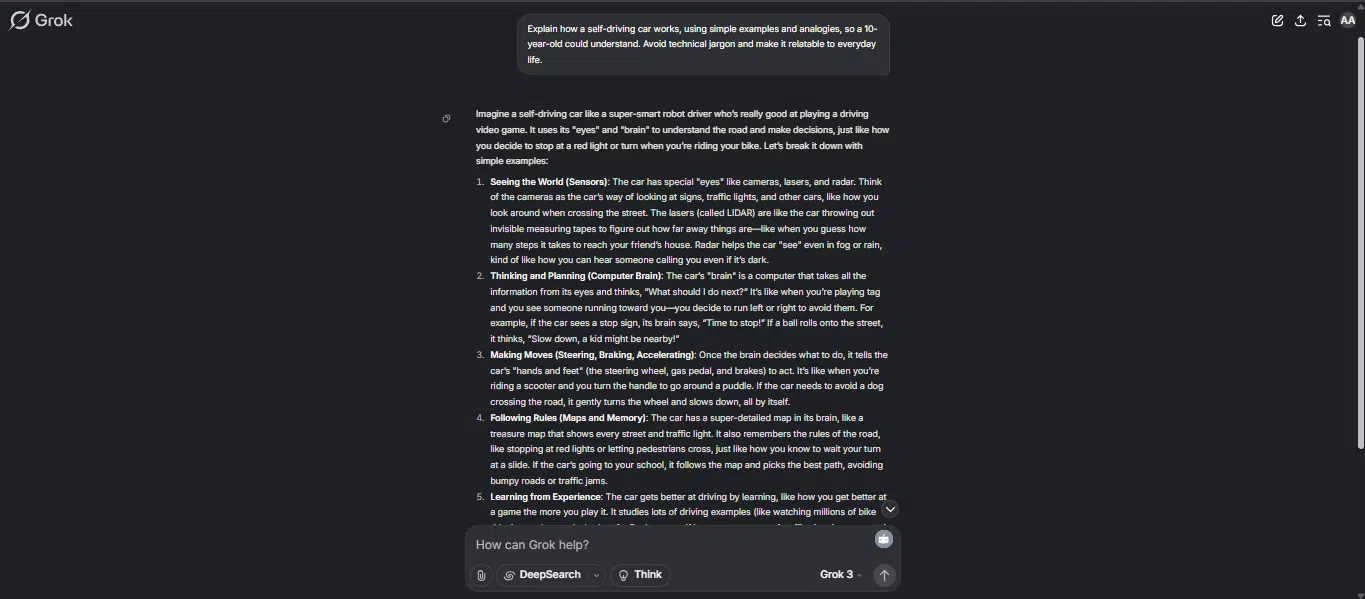

DeepSeek’s response:
DeepSeek’s response is concise and straight to the point. This makes it suitable for those looking for a quick explanation. It also offers a strong foundation with details to convey the main idea. The use of eyes & ears, brain, memory, and learning makes it easy to read and digest. However, its focus on surface-level details might not satisfy readers who want a broader understanding.
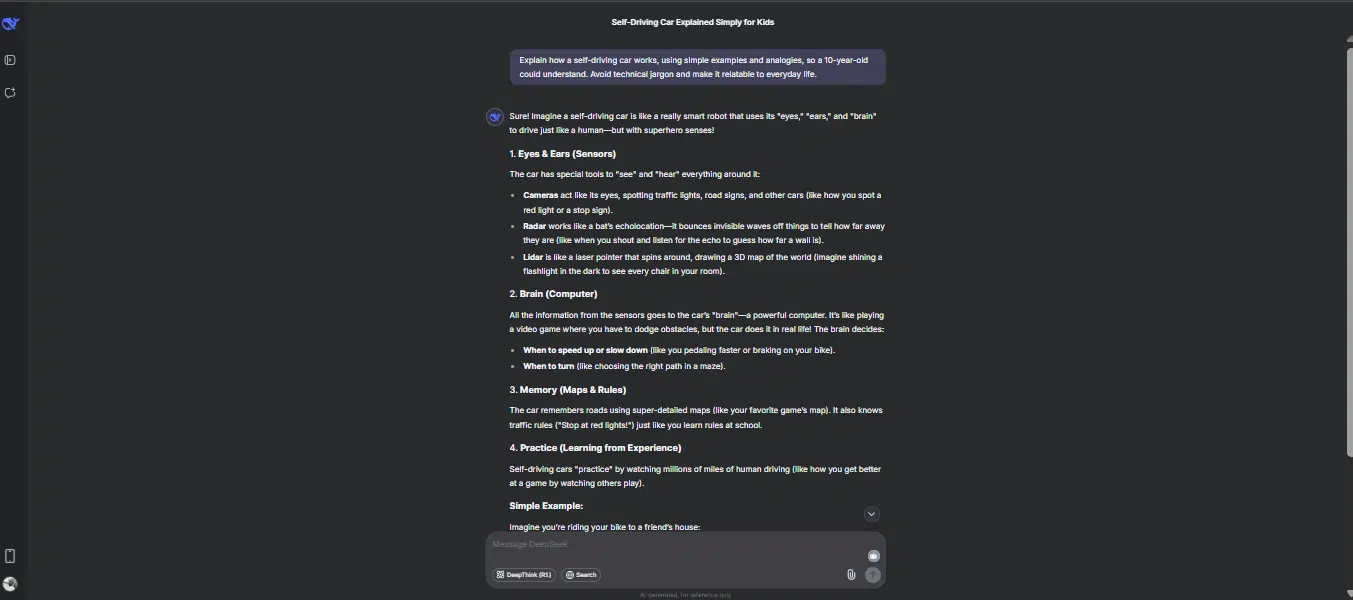

My winner: Grok 3 vs. DeepSeek for translating complex topics
Both models address the prompt properly. While Grok 3 offers depth, DeepSeek is concise and relatable. Although I prefer depth and would have picked Grok 3, however, for the context of the prompt, which includes a 10-year-old, DeepSeek does it better here.
Grok 3 vs. DeepSeek for conversation
- Prompt: Hello, let’s just talk like two friends who haven’t caught up in a while. Be a little nosy, ask me stuff about life, work, whatever. Make the conversation natural.
Grok3’s response:
Grok is energetic and uses a lot of slang. However, it feels a bit rushed and less natural.
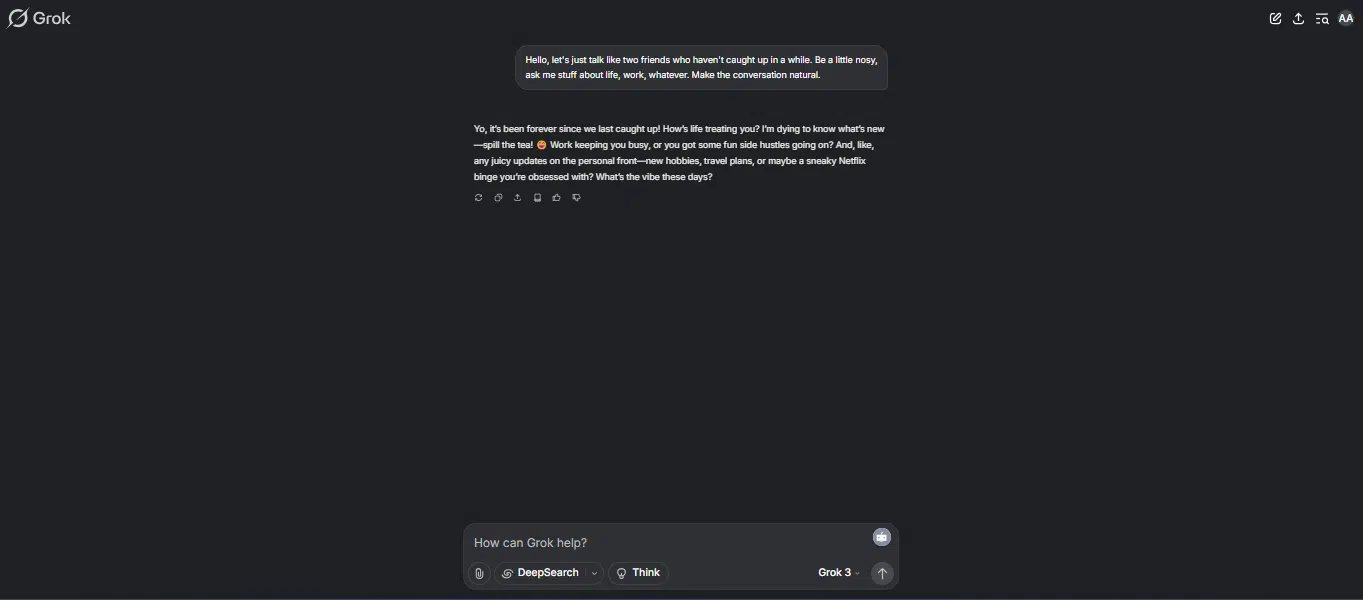
DeepSeek’s response:
However, DeepSeek feels more friendly and caring, asking thoughtful questions while keeping things fun. It feels like chatting with an actual friend who wants to know both the fun and serious parts of one’s life.
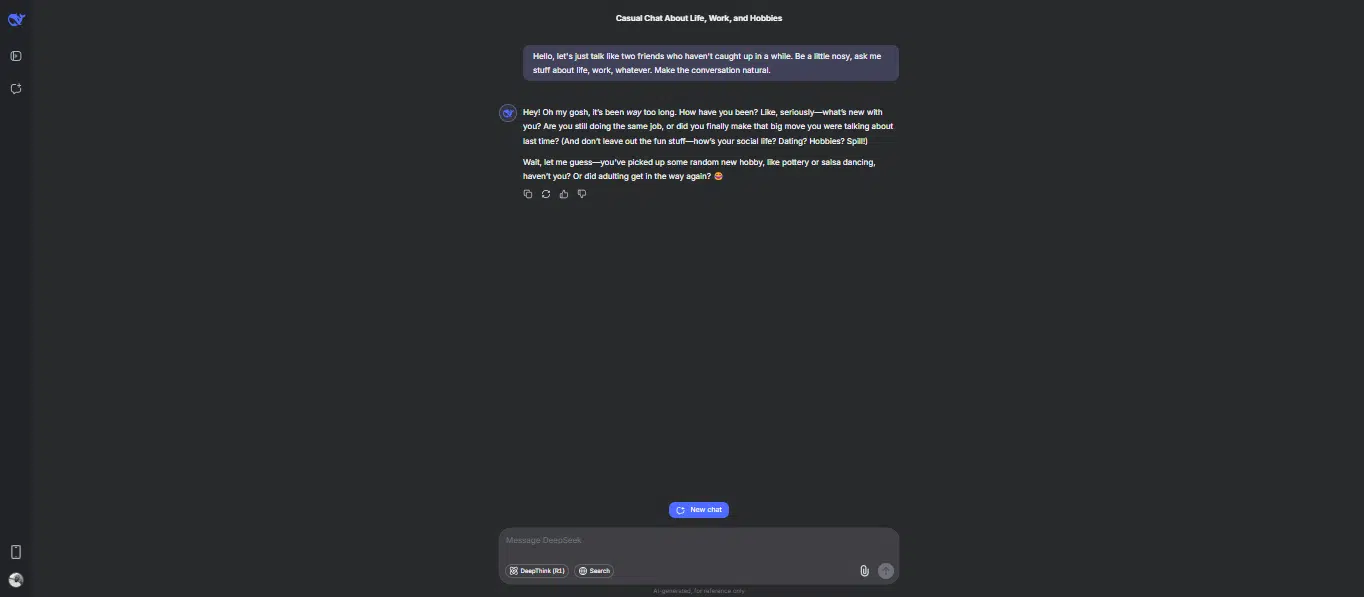
My winner: Grok 3 vs. DeepSeek for conversation
Here, I prefer DeepSeek because it feels more real, while Grok 3 works better for very casual, fun exchanges with a younger audience crowd.
Grok 3 vs. DeepSeek for scriptwriting
- Prompt: Imagine you’re writing a script for a short film where two characters are catching up after years apart. They meet at a café, and the conversation starts light but gradually delves into deeper topics like regrets, dreams, and what has changed in their lives. Write the dialogue between them, showing the contrast between their personalities through their tone, choice of words, and reactions. Keep the conversation realistic, emotional, and engaging. Do this in less than 400 words.
Grok3’s response:
Grok 3 offers a lighter and funnier tone with energetic characters who try to be funny amid serious discussion. I noticed dynamism here.
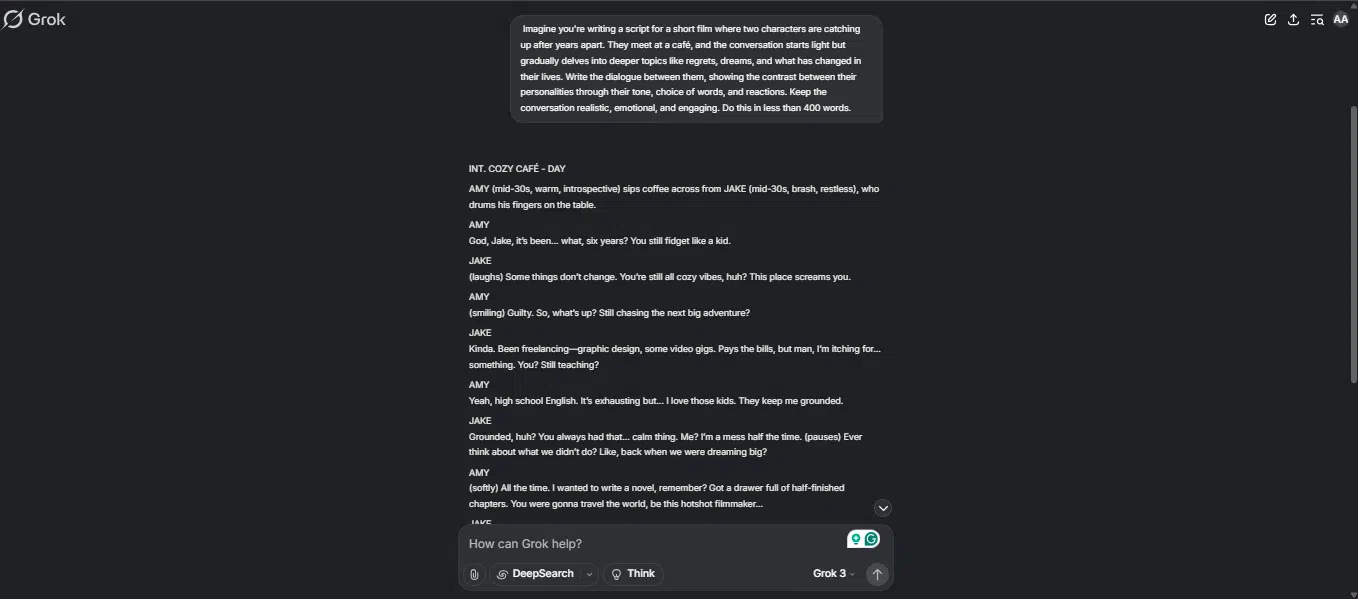
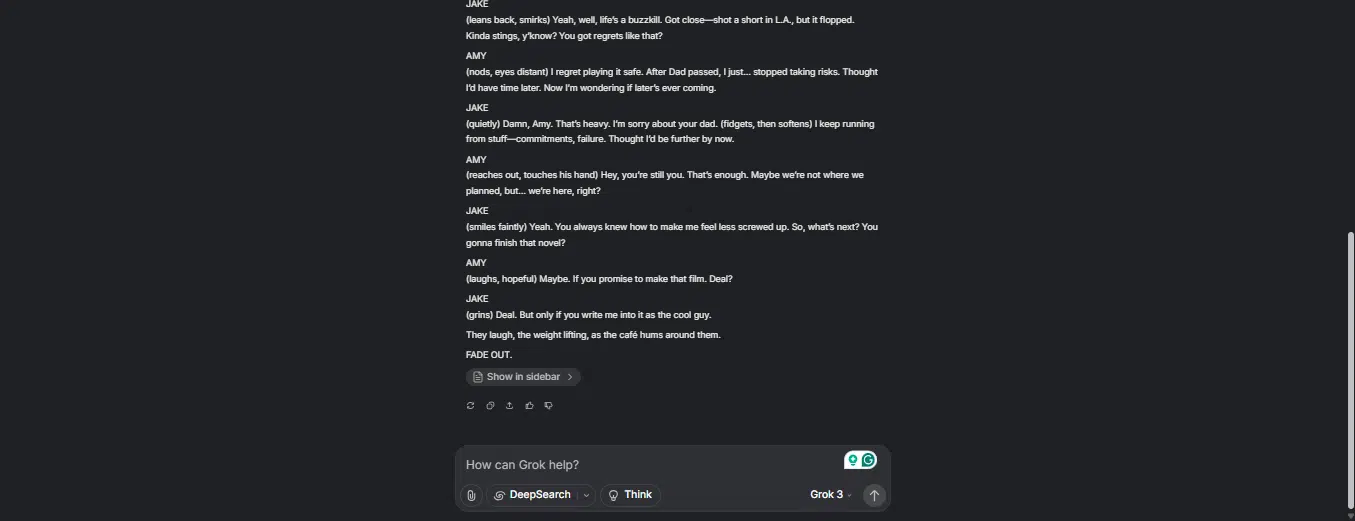
DeepSeek’s response:
However, DeepSeek’s response shows a reflective, sad tone. The characters’ reunion feels emotional, with a focus on regret and missed opportunities.


My winner: Grok 3 vs. DeepSeek for scriptwriting
Grok is my winner here because it mixes humor and serious moments well. It’s more lively and easier to follow, making it more enjoyable to read.
Conclusion
Following the Grok 3 vs. DeepSeek review, it is obvious that everything depends on what you need them for. For instance, this AI model comparison shows that Grok 3 gives detailed answers, suitable for people who appreciate depth. It performs well when you need a lot of information. This puts it ahead in categories like idea generation, fact-checking, news updates, marketing strategies, and scriptwriting. While it gives you the full picture, be informed that the answers can be a bit long.
However, DeepSeek performs better at being concise and easy to understand. It gets straight to the point and can be engaging. It also outperforms Grok 3 in aspects like solving math problems, summarization, creative writing, translating complex topics, and conversation ability.
This AI performance evaluation points to the fact that if you want a lot of details and facts, Grok 3 should be your choice. Meanwhile, if you need clear, creative, or friendly responses, DeepSeek is a better choice. In all, the best way to use these AI tools is to know what each one is good at and use them for those specific tasks.
If you have had a chance to experiment with Grok 3 or DeepSeek, we would appreciate it if you shared your experience, including which model you find more useful. While you stay informed about the latest in AI and technology, subscribe to our newsletter for more in-depth reviews, and feel free to share your thoughts and opinions in the comments below.
Disclaimer!
This publication, review, or article (“Content”) is based on our independent evaluation and is subjective, reflecting our opinions, which may differ from others’ perspectives or experiences. We do not guarantee the accuracy or completeness of the Content and disclaim responsibility for any errors or omissions it may contain.
The information provided is not investment advice and should not be treated as such, as products or services may change after publication. By engaging with our Content, you acknowledge its subjective nature and agree not to hold us liable for any losses or damages arising from your reliance on the information provided.

